| NGC 2264 NGC 2264 is a diffuse emission nebula in the constellation Momoceros. It's unusual in that the NGC designation also includes the Cone Nebula, the Snowflake Nebula and the Christmas Tree Nebula. All of these objects lie around 2300 light-years from Earth. In the center of the nebula are a number of hot, new stars that are hot enough to excite the nearby gasses enough that they begin to glow in visible light. Image processed by Ron Yelton, original data from Telescope Live |
Sh2-129,
OU4 - The Flying Bat and Squid Nebulae In the constellation Cepheus is the large nebula - The Flying Bat, and right in the middle is the very faint Squid Nebula. This one was really difficult to process. Just couldn't figure out how to bring out the purplish Squid. This one would be worth re-doing sometime when I have a little more Pixinsight under my belt. They both lie about 2300 light-years away and the Squid nebula is about 50 light-years across. Image processed by Ron Yelton, original data from Telescope Live |
NGC 1499 - The California Nebula the California Nebula is an emission nebula in the constellation Perseus. Although in this image it looks fairly bright, it actually has a very low surface brightness which makes it difficult to observe visually. It lies about 1000 light-years from the Earth. Image processed by Ron Yelton, original data from Telescope Live |
|
Location: IC Astronomy
Observatory, Spain Date: November 2020 - September 2022 Mount: Paramount MX+ Telescope: FSQ-106EDX4 (SPA-3) Camera: FLI PL16083 Exposure: 42 x 5 min for Ha, OIII and SII. Total: 10 hr 30 min |
Location:
El Sauce Observatory,
Chile
Date: July 28, 2023 Mount: Officina Stellare EQ Mount Telescope: Officina Stellare Pro RC 700 (27" f/8) (SPA-2) Camera: QHY600m @-25c Exposure: 24 x 5 min each for Ha, OIII and SII. Total: 6 hrs |
Location: IC Astronomy Observatory, Spain
Date: August 2023 Mount: Paramount MX+ Telescope: Takahashi FSQ-106ED (SPA-1) Camera: QHY600m CMOS @ -25c Exposure: HSO 18 x5 min Total: 4.5 hrs |
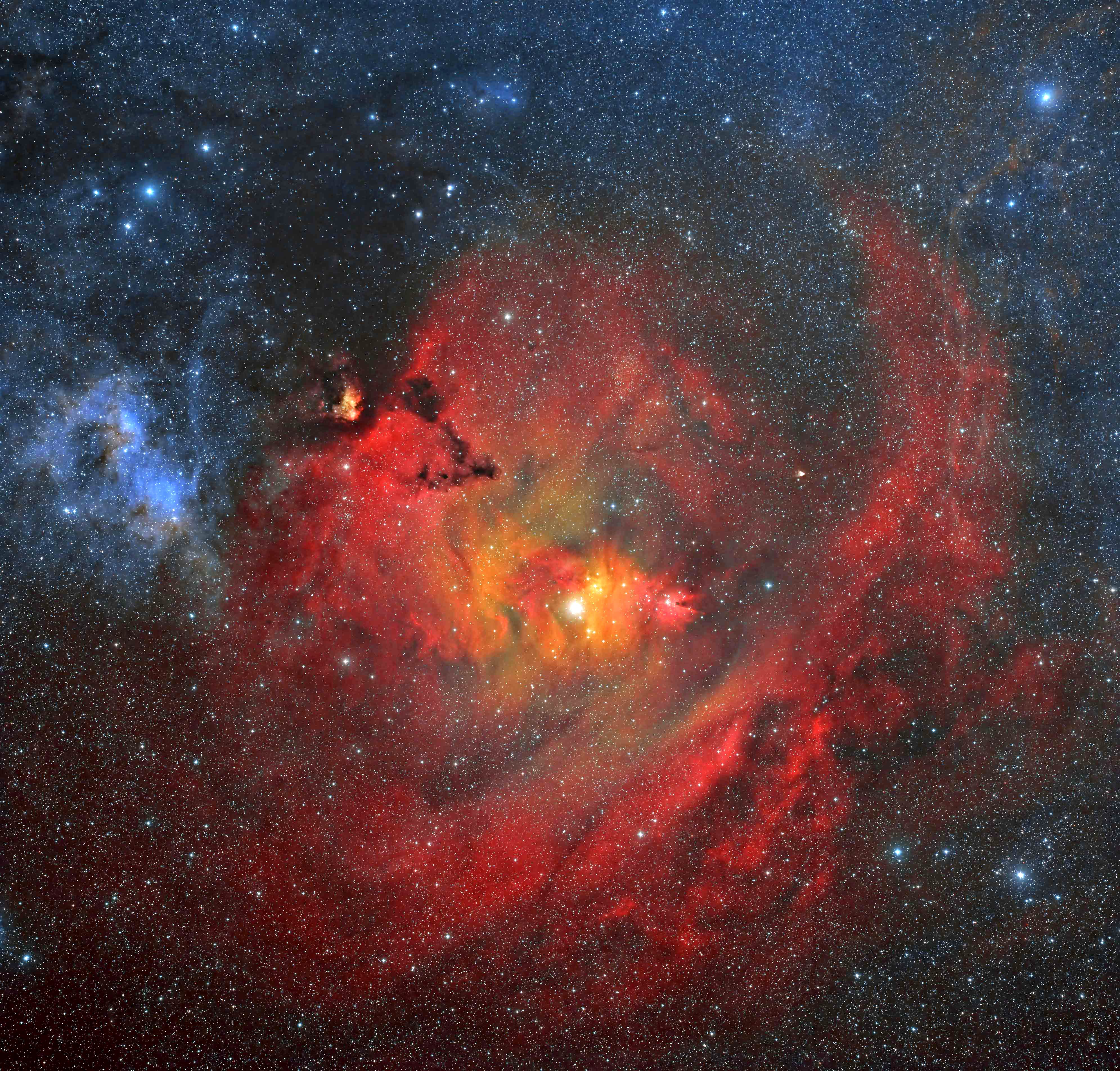 |
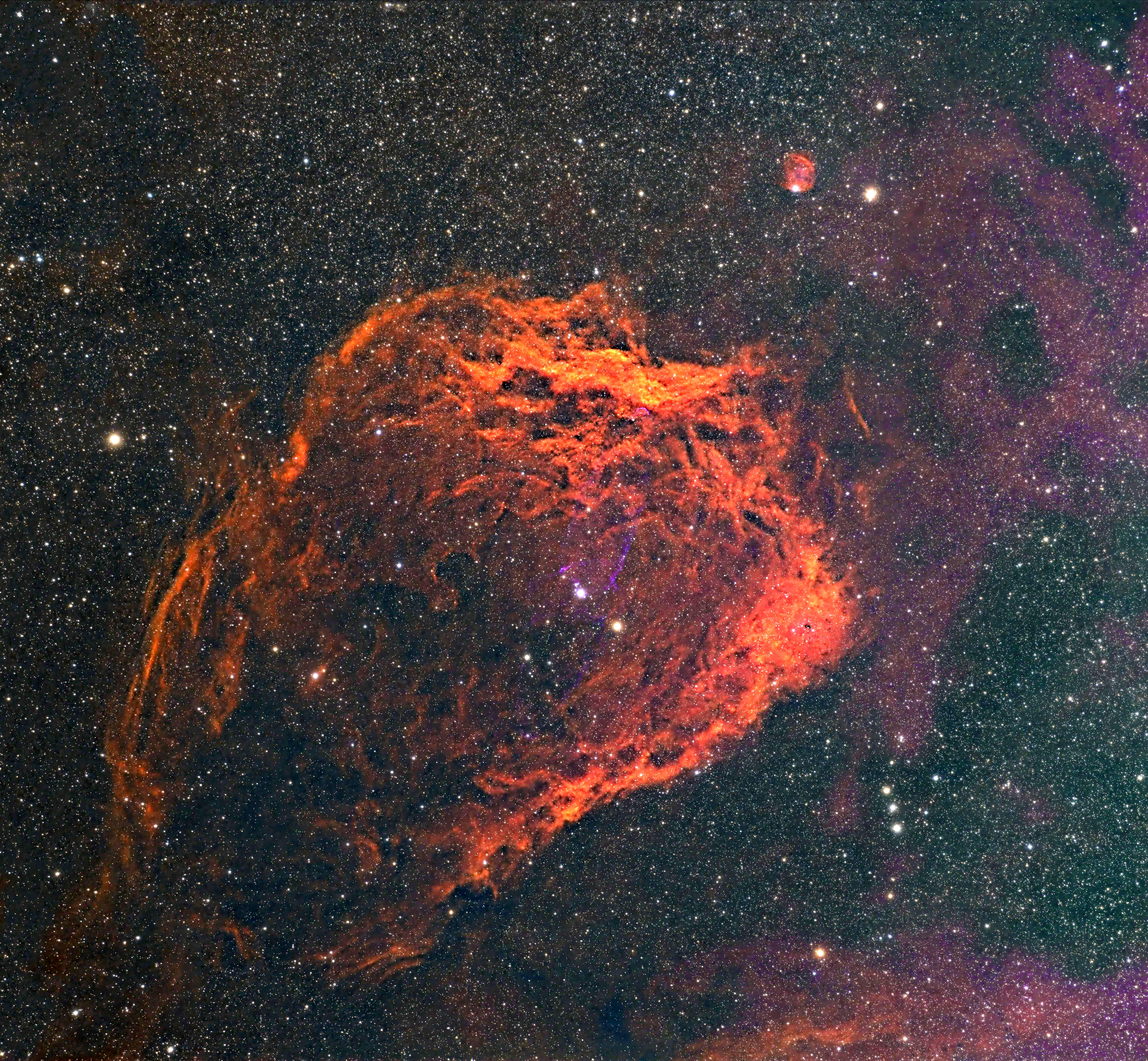 |
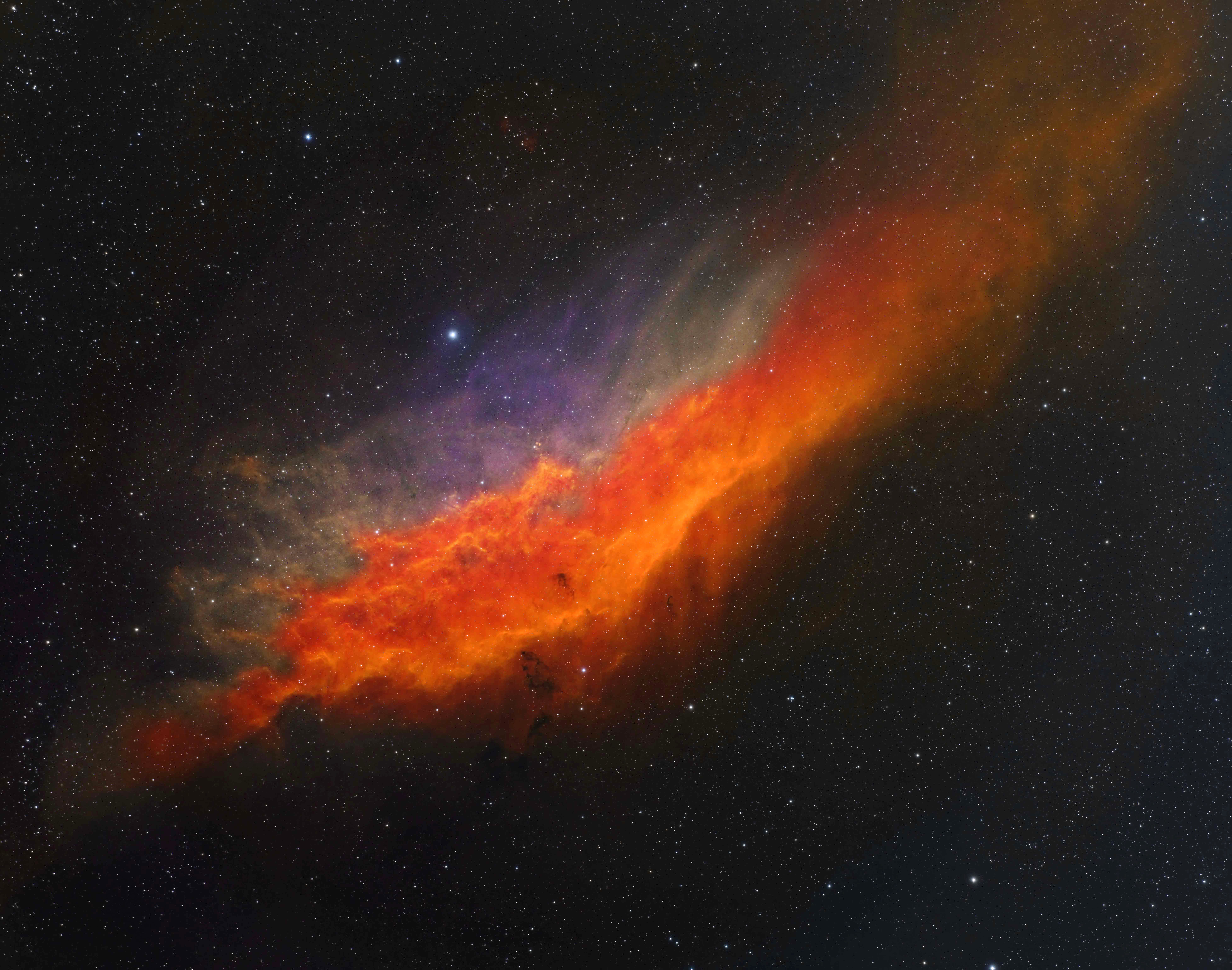 |
| Henize 70 Henize 70 was first observed in 1950. Originally it was thought to be a Supernova remnant. Then in 1956 it was added to catalogs as a planetary and emission nebula. Over the years most astronomers stuck with the supernova theory. As it turns out, Henize 70 is a Superbubble - a mass of gas that seems to be eroding from nearby stellar winds. This image is a second version - experimenting with some new processing techniques. The first version is on the second Nebula page and was processed in SHO. This version was processed in HOO. Image processed by Ron Yelton, original data from Telescope Live |
IC 4812 - The Coalsack Nebula The Coalsack Nebula lies about 600 light-yeas from Earth in the Southern constellation of Crux (the Southern Cross). it is one of the rare DSOs that can be seen with the naked eye.It plays an important part in the mythologies of the Australian Aboriginal People, and forms the head of the Emu in the Sky. For the Inca people this nebula was called Yutu, a partridge-like bird in South America. Image processed by Ron Yelton, original data from Telescope Live |
In September of 2023 I was
lucky enough to have one of my images selected
as the Telescope Live Picture of the Day. It's
really nice to be recognized. The picture is
the one directly to the left. |
|
Location: El Sauce
Observatory, Chile Date: February - March 2023 Mount: Mathis MI-1000/1250 Telescope: Planewave CDK24 (CHI-1) Camera: QHY600m @ -25c Exposure: 15 x 10 min for HSO Total: 3 hrs 15 min |
Location:
Heaven's Mirror Observatory,
Australia
Date: August 2023 Mount: Paramount MX+ Telescope: FSQ-106ED (AUS-2) Camera: QHY600m @ -25c Exposure: 12 x 5 min each for LRGB. Total: 4hrs |
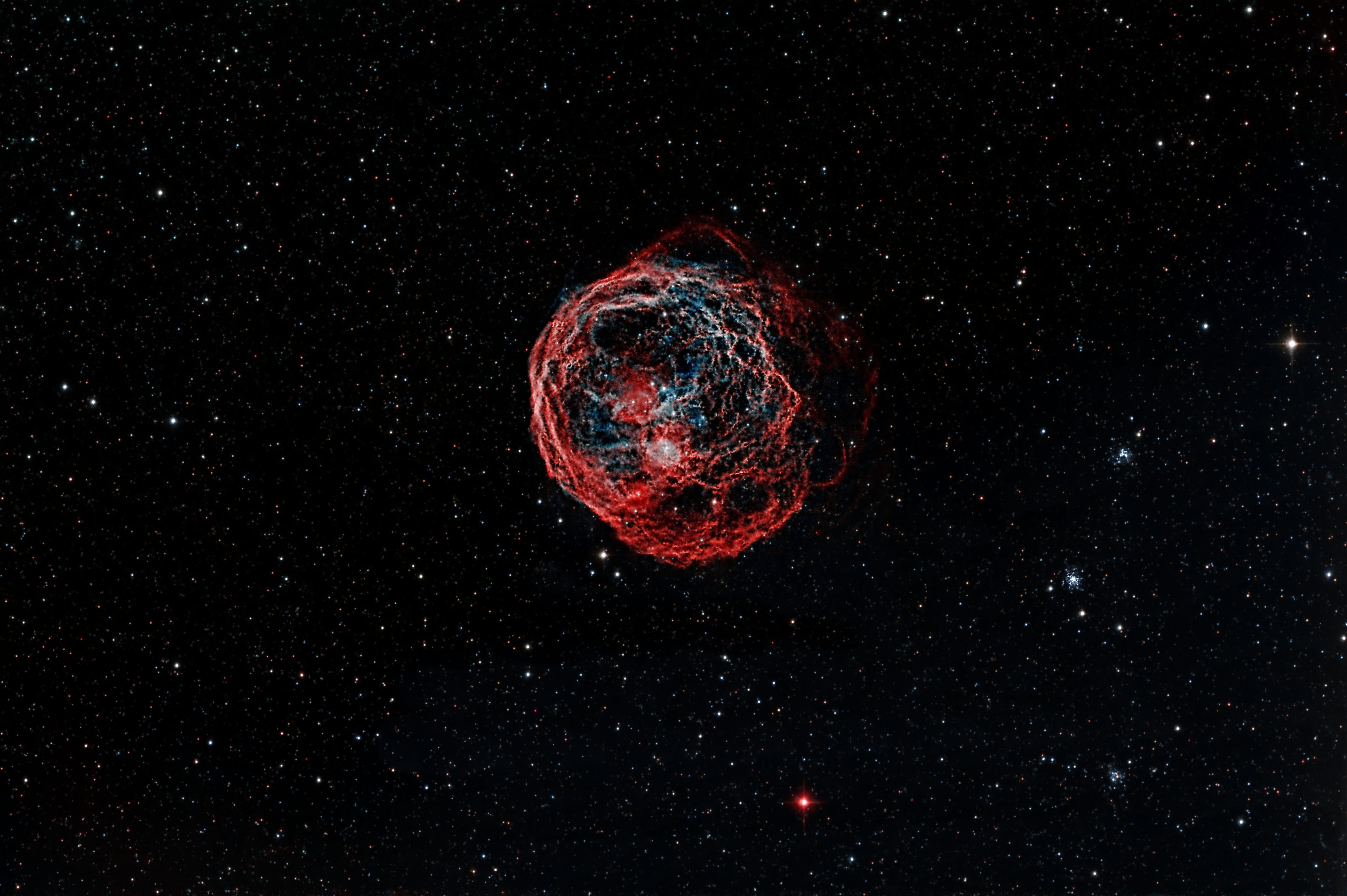 |
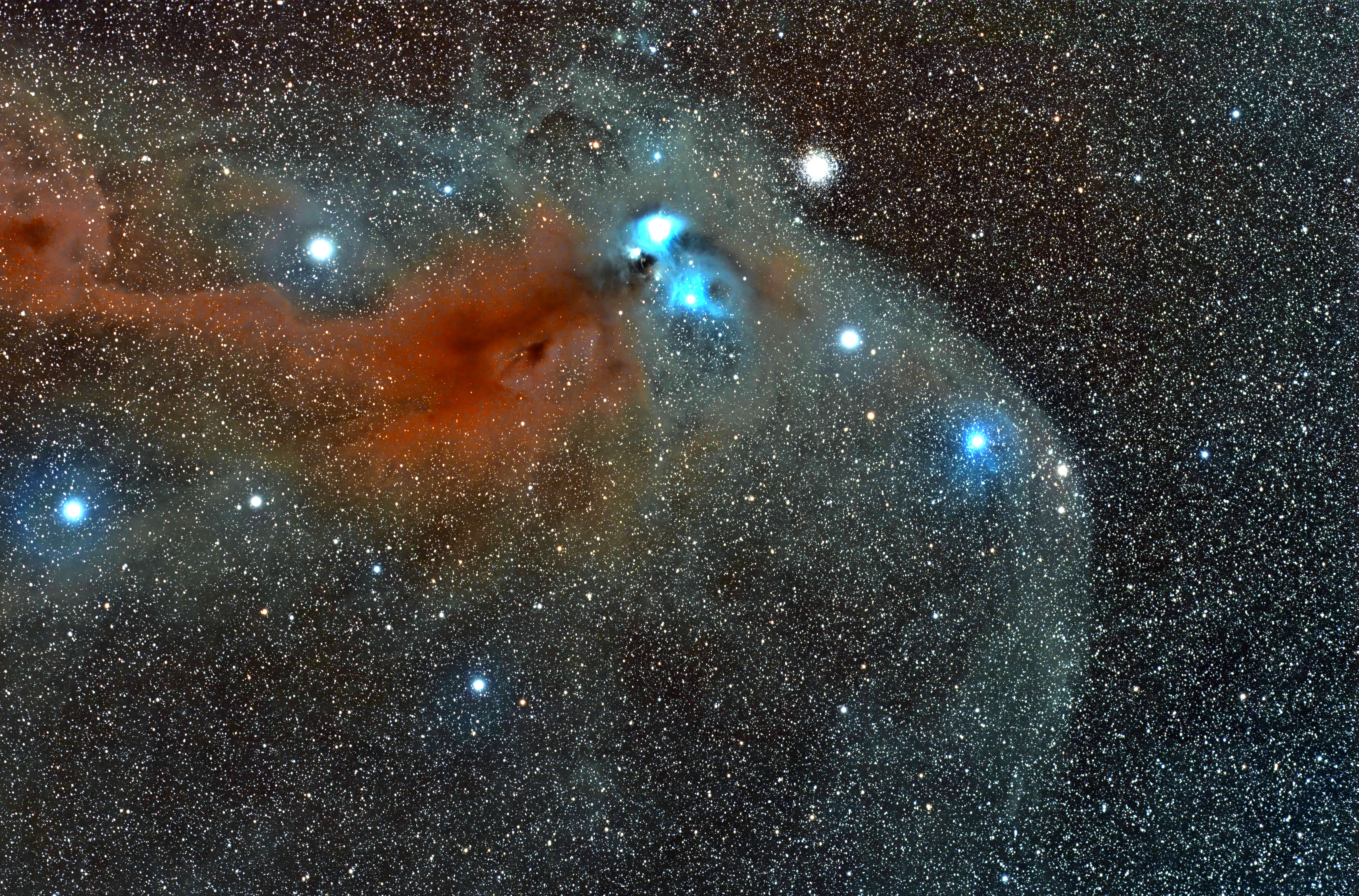 |
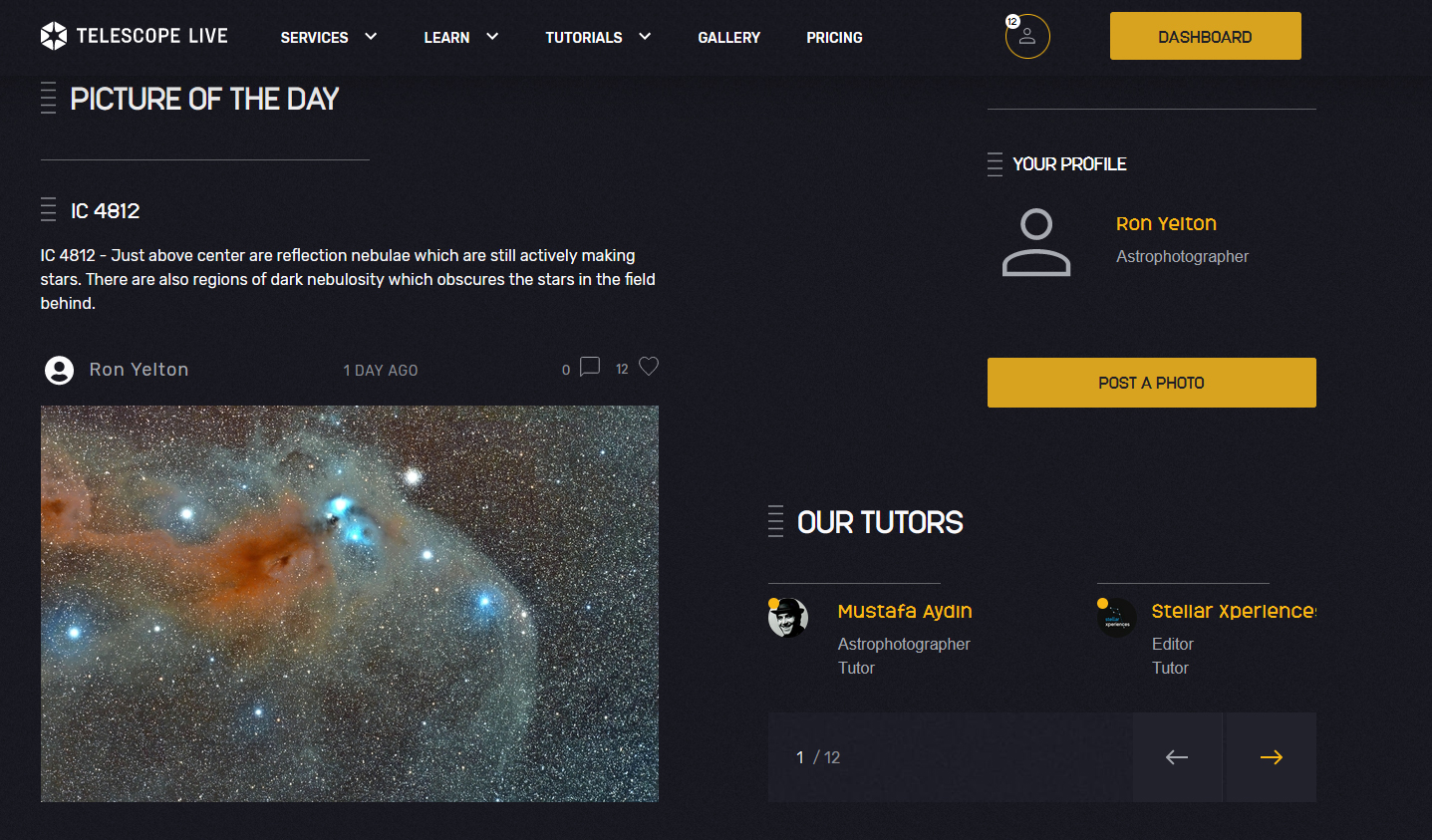 |
| Messier 16 - The
Eagle Nebula (Pillars of Creation) ln the constellation Serpens lies Messier 16, a diffuse emission nebula. It is about 5700 light-years from Earth and contains numerous active star making regions and clusters, the main cluster containing around 8100 stars. The Eagle Nebula was made famous in 1995 when a Hubble image was released that came to be named "The Pillars of Creation." The Pillars are an excellent example of the erosion of the molecular cloud that formed the hot, new stars. The intense radiation from the new stars is what causes the erosion. Image processed by Ron Yelton, original data from Telescope Live |
Messier 42 - The
Great Orion Nebula Measuring about 24 light-years across and 13.45 light-years from Earth, the Great Orion Nebula is a prime example of an emission nebula. It is a naked-eye object and can be identified as the middle "star" in Orion's sword. It is the most photographed and studied nebula and has added considerably to our knowledge of star and planetary systems formation. This is one of several M42s that I've done with various different telescopes and cameras. it's fun to re-do an image as I learn new techniques in processing. Image processed by Ron Yelton, original data from Telescope Live |
Messier 42 - The
Great Orion Nebula This another version of the Orion Nebula using the same data set as the image to the left. This time I incorporated some of the processes in Affinity Photo 2. I actually came across this look by accident. It was a version that popped up when I was using Tone Mapping Persona. This would be an awesome image if I could figure out how to lighten the left side without lightening the rest of the image. There's still a lot of nebulosity hidden in there. Image processed by Ron Yelton, original data from Telescope Live |
|
Location: El Sauce
Observatory, Chile Date: February - April 27, 2020 Mount: Mathis MI-1000/1250 Telescope: Planewave CDK24 (CHI-1) Camera: QHY600m @ -25c Exposure: 17 x 10 min for LRGB Total: 2 hrs 50 min |
Location: El Sauce
Observatory, Chile Date: December 2020 - February 2021 Mount: Mathis MI-1000/1250 Telescope: Planewave CDK24 (CHI-1) Camera: FLI ProLine PL9000 @ -25 Exposure: 30 x 30 sec for LRGB Total: 1 hr |
Location: El Sauce
Observatory, Chile Date: February - April 27, 2020 Mount: Mathis MI-1000/1250 Telescope: Planewave CDK24 (CHI-1) Camera: FLI ProLine PL9000 @ -25 Exposure: 30 x 30 sec for LRGB Total: 1 hr |
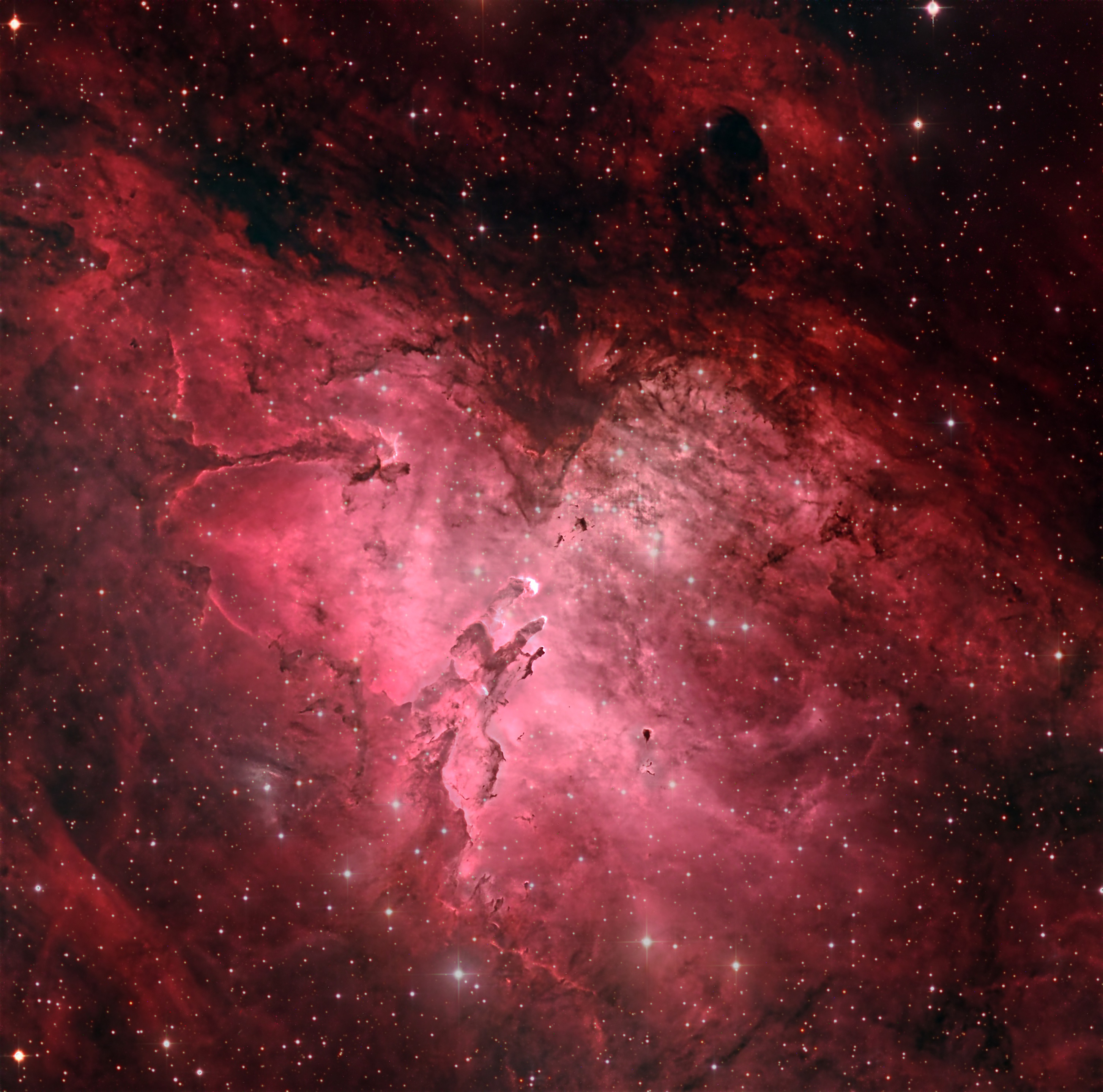 |
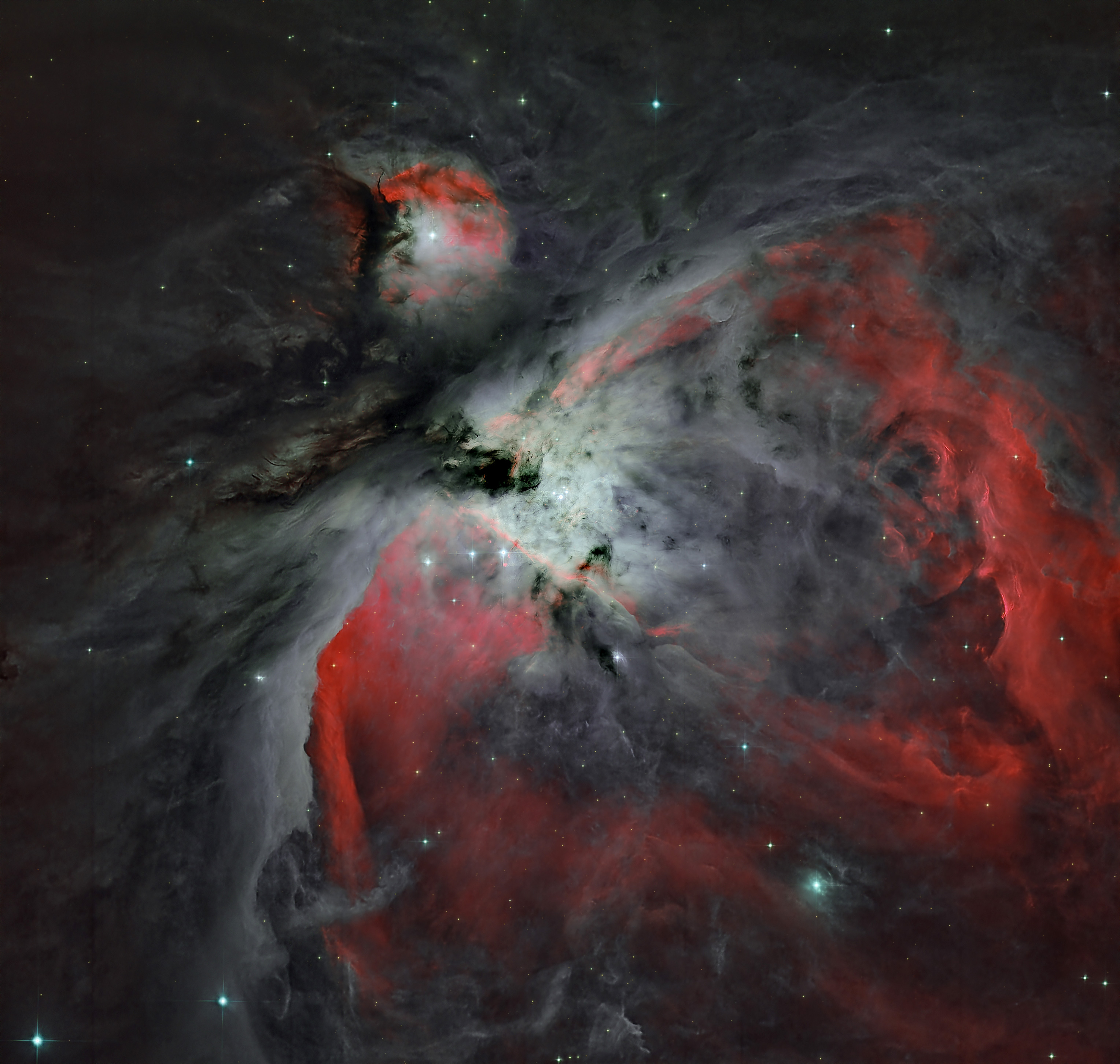 |
| NGC 3293 In the constellation Carina lies NGC 3293, an open cluster, which boasts over 100 stars. It was discovered by Nicholas-Louis de Lacaille in 1751.Two of the brand new stars are blue super-giants. it is about 12 million years old. the most massive of the stars have congregated toward the center of the cluster. Image processed by Ron Yelton, original data from Telescope Live |
Messier 17 - The Omega Nebula or
Swan Nebula Lying about 5500 light-years from Earth, the nebula spans around 15 light-years in diameter. The larger cloud of gas and dust from which the nebula formed is about 40 light-years in diameter. It is one of the most massive and brightest star-forming regions in our own Milky Way. It was discovered by Phillipe Loys de Cheseaux in 1745 and finally cataloged by Charles Messier in 1765. Image processed by Ron Yelton, original data from Telescope Live |
Sharpless-86 (Sh2-86) This nebula an emission and dark nebula located in the constellation Vulpecula. There are numerous pillars of dust and gas that are eroding because of the stellar radiation (solar wind) from the star cluster that is center-left (NGC 6823). there are also numerous BOK nodules throughout the nebula. The nodules are areas around protostars where planets will form around that particular star. Image processed by Ron Yelton, original data from Telescope Live |
|
Location: El Sauce
Observatory, Chile Date: June 5 - July 3, 2023 Mount: Mathis MI-1000/1250 Telescope: Planewave CDK24 (CHI-1) Camera: QHY600m @ -25c Exposure: 32 x 5 min for HSO Total: 16 hrs |
Location: El Sauce
Observatory, Chile Date: April 4, 2020 Mount: Mathis MI-1000/1250 Telescope: Planewave CDK24 (CHI-1) Camera: FLI ProLine PL9000 @ -25 Exposure: 12 x 10 min for LRGB Total: 2 hrs 40 min |
Location: El Sauce
Observatory, Chile Date: September 2023 Mount: Mathis MI-1000/1250 Telescope: Planewave CDK24 (CHI-1) Camera: QHY600m @ -25c Exposure: 7 x 5 min for HOO Total: 1 hrs 45 min |
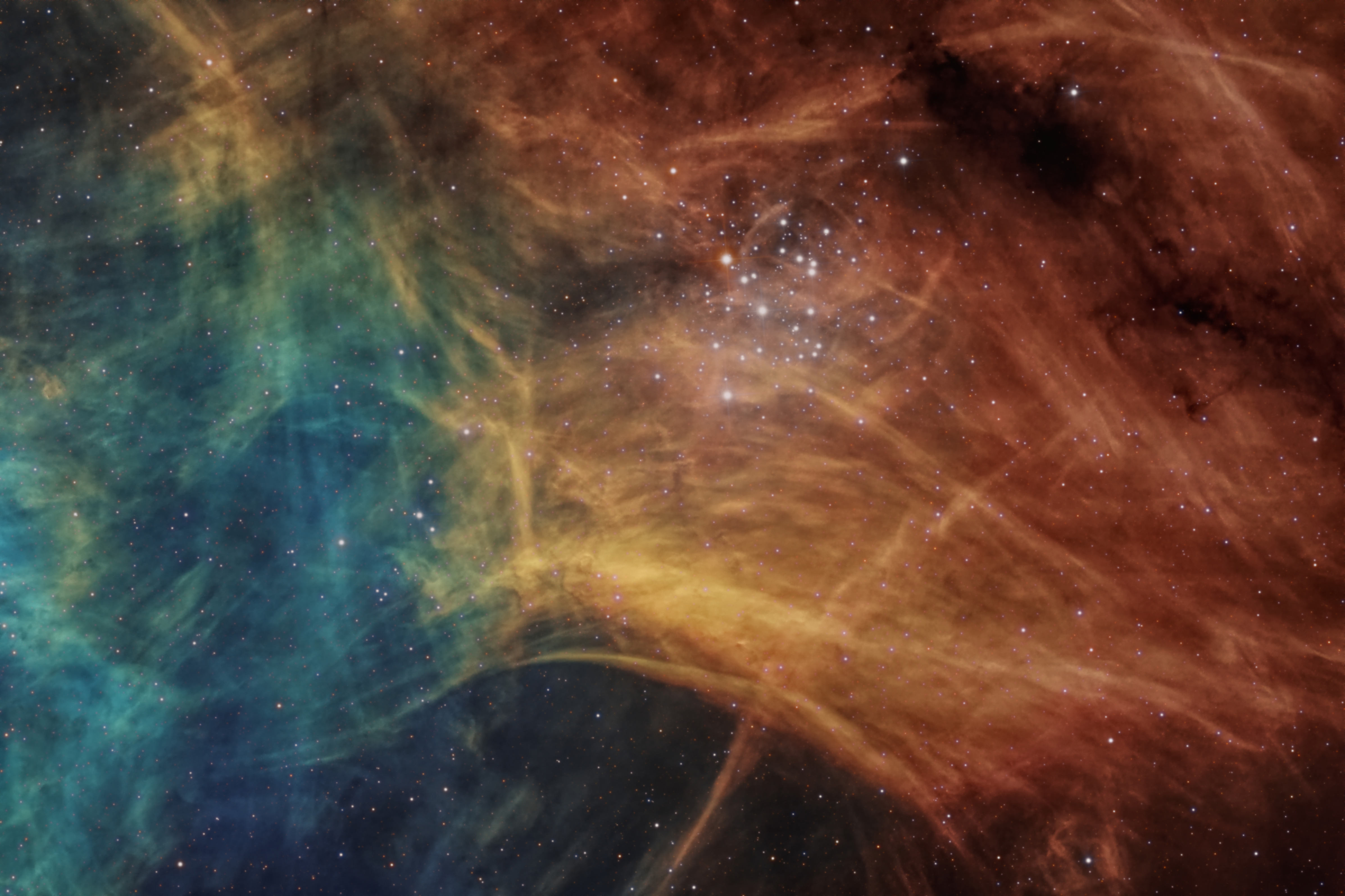 |
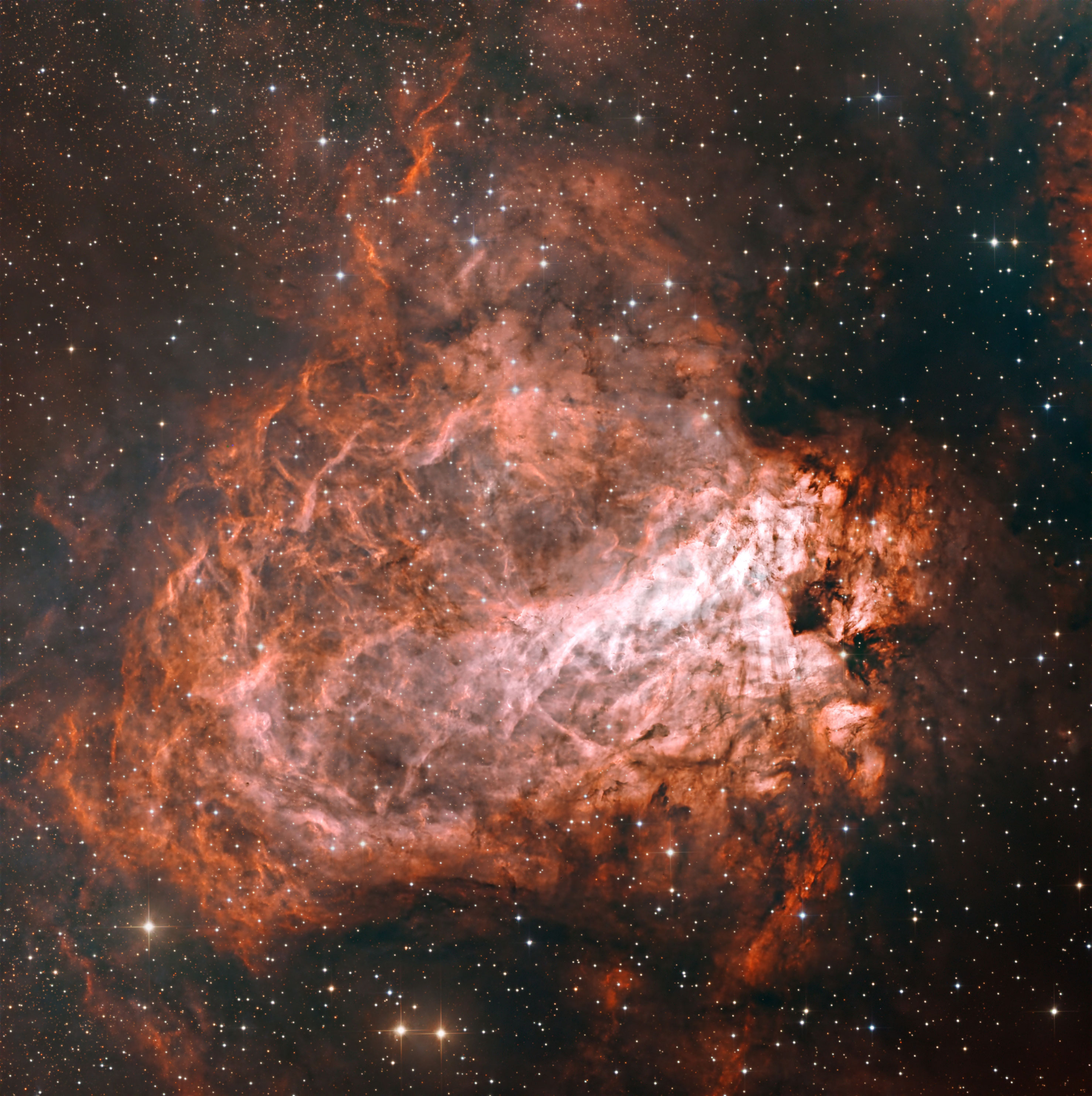 |
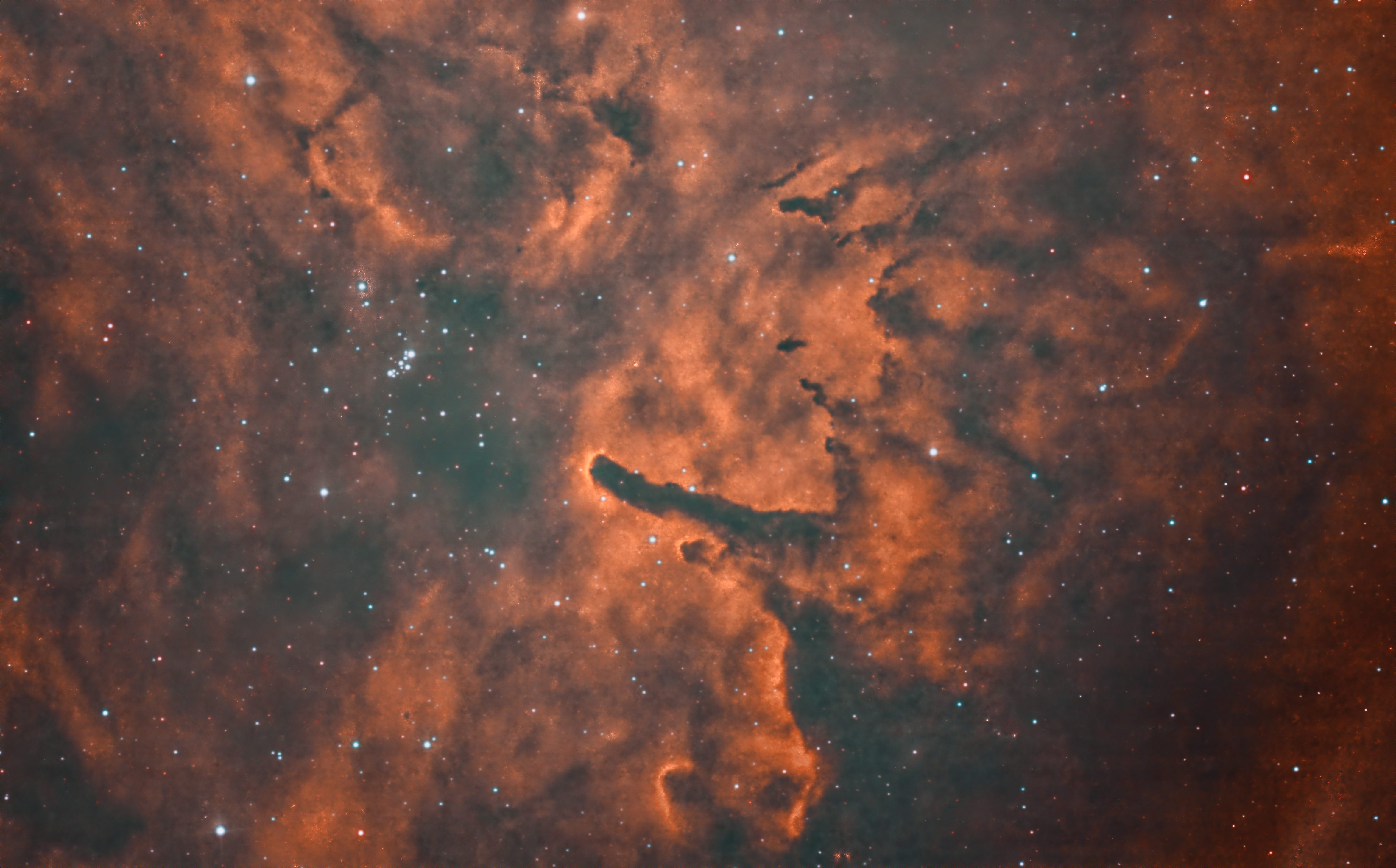 |
| Small Magellanic Cloud (SMC) NGC
292 The Small Magellanic cloud is a companion galaxy to our own Milky way and sits avbout 200,000 light-years from us. It is an irregular dwarf galaxy and has a mass of about 7 billion solar masses with several hundred million stars. It is one of the most distant objects that can be seen with the naked eye. It is visible throughout the entire southern hemisphere and up to about 15 degress north of the Equator. Image processed by Ron Yelton, original data from Telescope Live |
Large Magellanic Cloud (LMC) LRGB The LMC is a satellite galaxy to the Milky Way. it lies about 163,000 light-years away.The LMC is classified as a Magellanic spiral, in that It contains a stellar bar that is geometrically off center, suggesting that it was a barred dwarf spiral galaxy before its spiral arms were disrupted, likely by tidal interactions from the Small Magellanic Cloud (SMC) and the Milky Way's gravity. This a standard LRGB image. Image processed by Ron Yelton, original data from Telescope Live |
Large Magellanic Cloud (LMC) HLRGB This image is almost exactly the same as the one just to the left. The difference is that this one has Hydrogen Alpha (Ha) added. Hydrogen, in this case is in the red channel which accentuates the hydrogen regions in the image. The bright white area in the lower-right is the Tarantula Nebula. Image processed by Ron Yelton, original data from Telescope Live |
|
Location:
Heaven's Mirror Observatory,
Australia
Date: August 2023 Mount: Paramount MX+ Telescope: FSQ-106ED (AUS-2) Camera: QHY600m @ -25c Exposure: 25 x 5 min each for HOO. Total: 2hrs 5 min |
Location:
Heaven's Mirror Observatory,
Australia
Date: March and April 2023 Mount: Paramount MX+ Telescope: FSQ-106ED (AUS-2) Camera: QHY600m @ -25c Exposure: 48 x 10 min each for LRGB. Total: 8 hrs |
Location:
Heaven's Mirror Observatory,
Australia
Date: March and April 2023 Mount: Paramount MX+ Telescope: FSQ-106ED (AUS-2) Camera: QHY600m @ -25c Exposure: 60 x 10 min each for HLRGB. Total: 10 hrs |
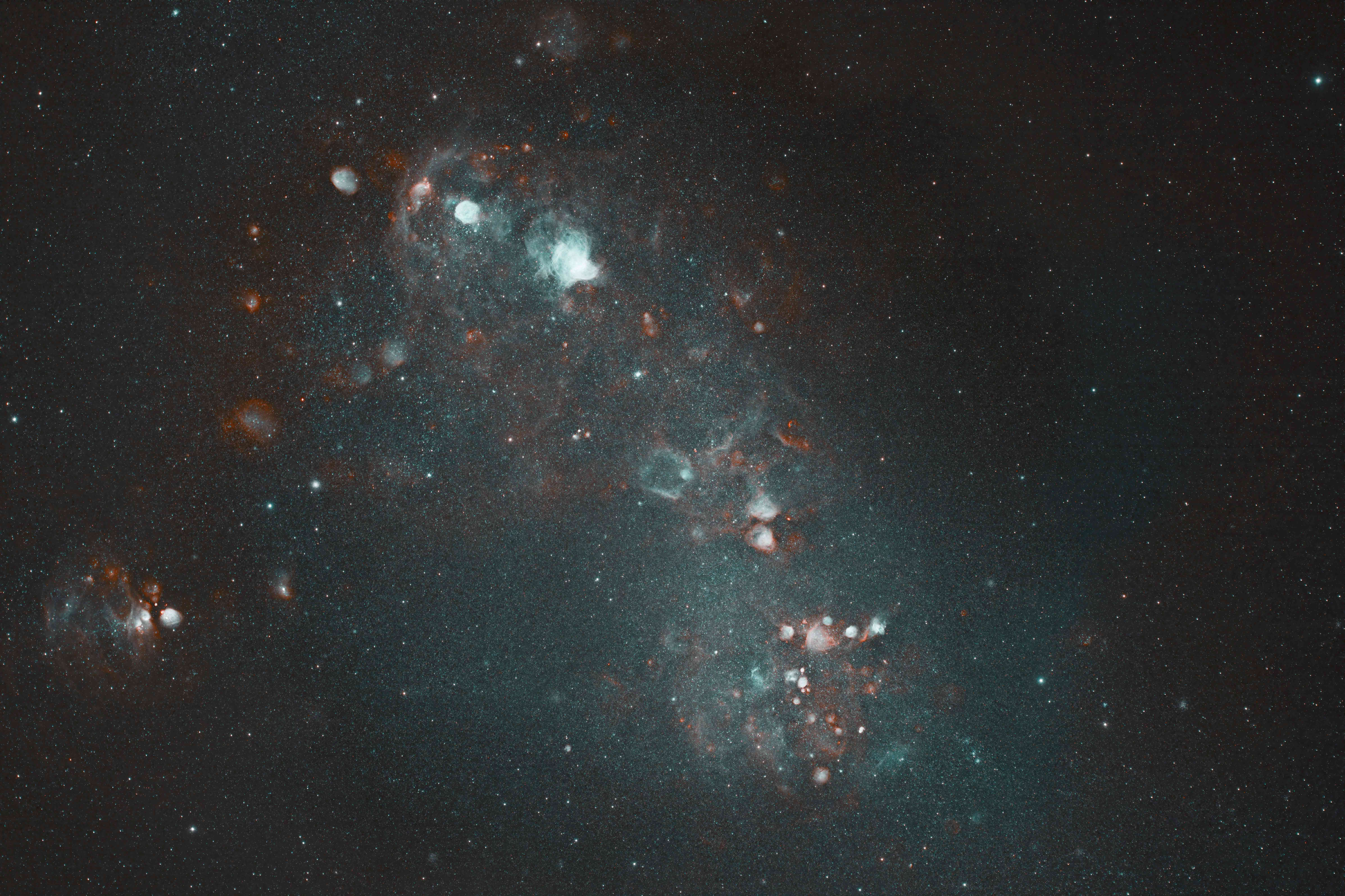 |
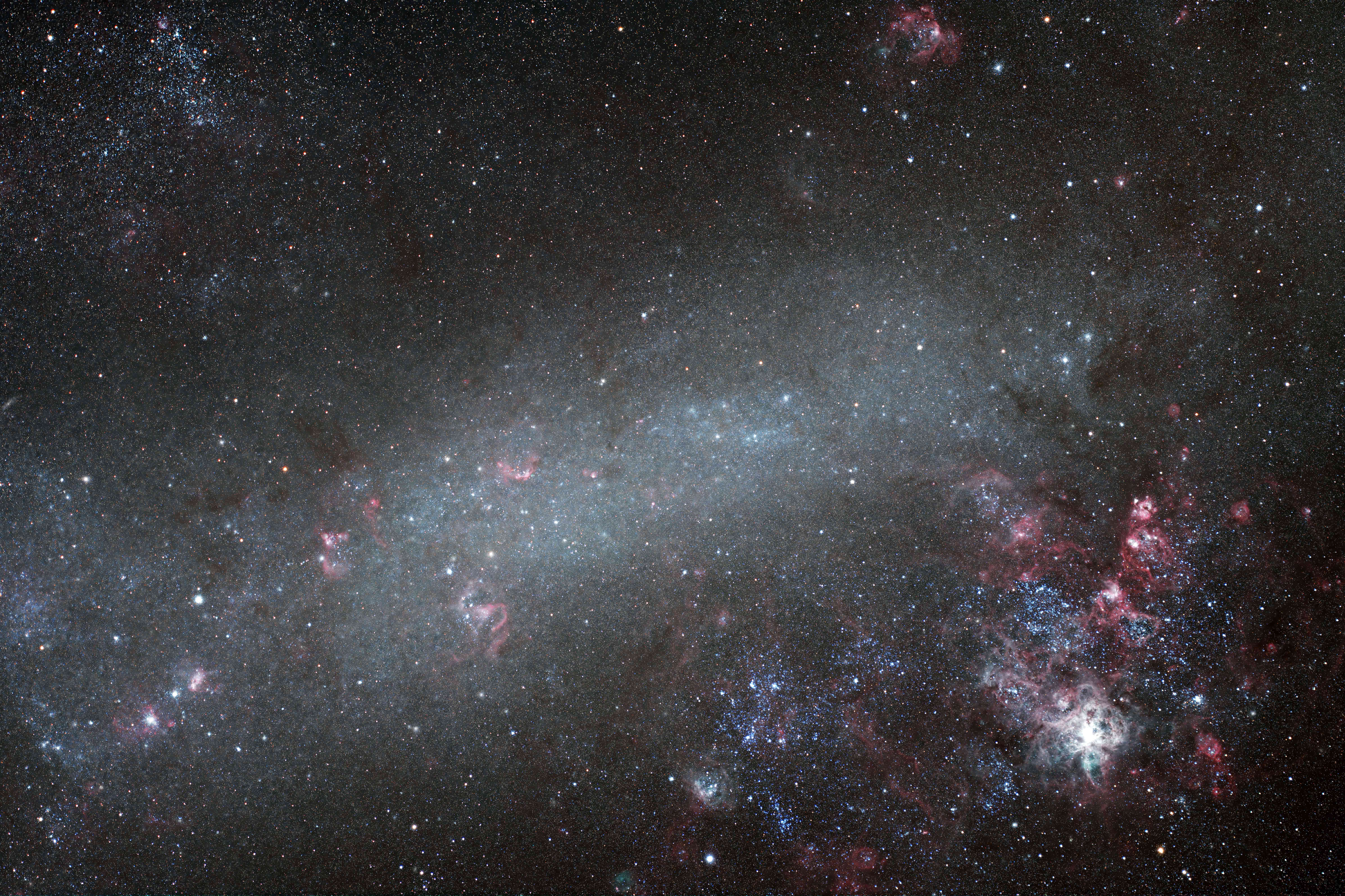 |
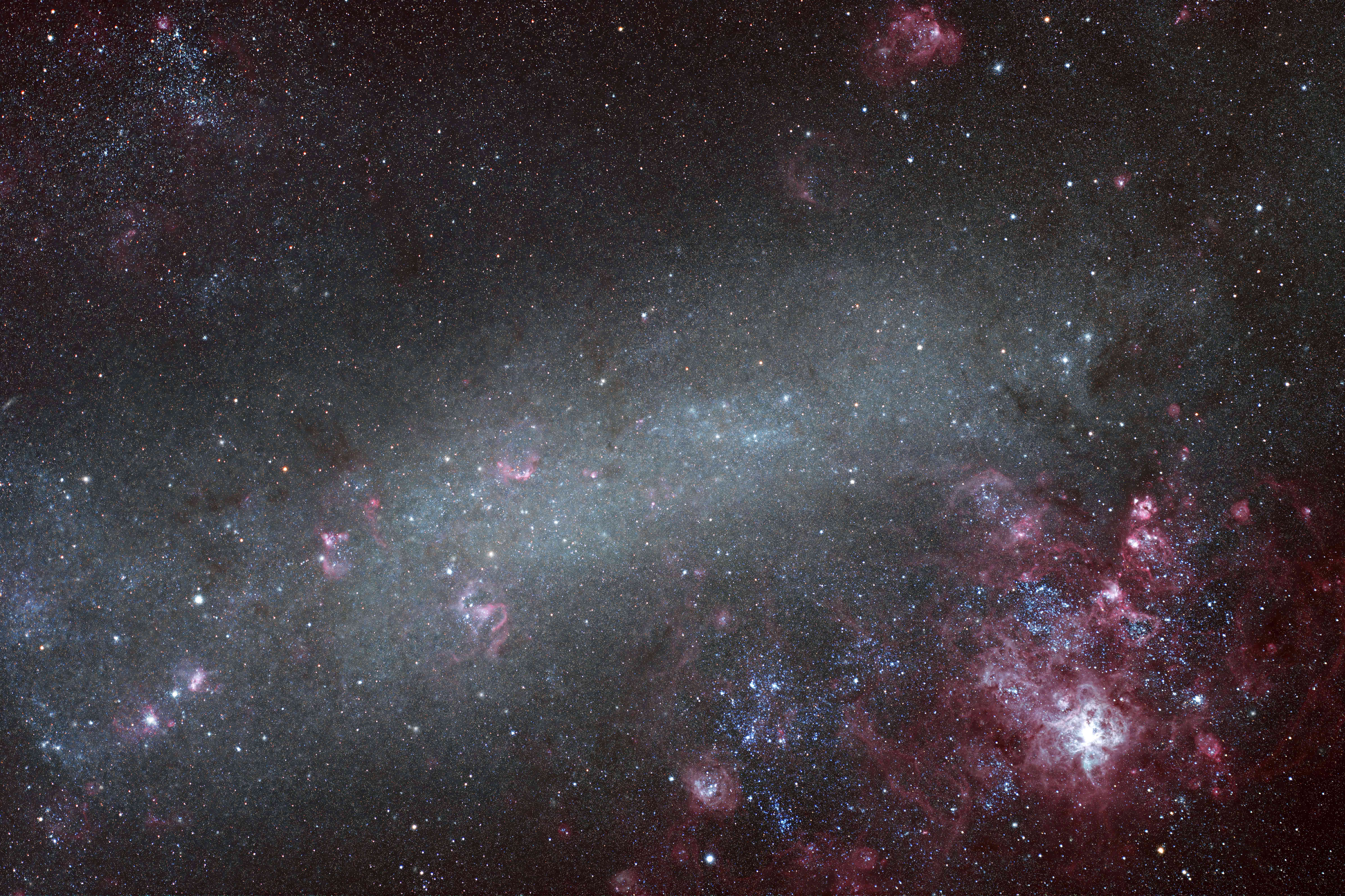 |
| NGC 2070 - The Tarantula Nebula The Tarantula Nebula is a large HII region in the Large Magellanic Cloud. in the previous two images above, it is the bright area in the lower-right of the LMC. It lies about 160,00 light-years from Earth. it is also one of the most luminous non-stellar objects in the sky. If it were as close to us as the Orion Nebula it would cast visible shadows. It is also the most active starburst region in our local group of galaxies. Image processed by Ron Yelton, original data from Telescope Live |
NGC 2064 NGC 2064 is a reflection nebula in the constellation Orion. The colors of the nebula are due to the reflected light of young, very hot, bright stars in the central blue area. It was first cataloged by John Louis Emil Dreyer in 1888. I like this image as it has some pretty cool texture. Image processed by Ron Yelton, original data from Telescope Live |
NGC 6729 Located 424 light-years from us in the constellation Corona Australis lies this emission/reflection nebula. Some areas glow due to stellar radiation from stellar nurseries while other areas simply reflect the light from new, very hot stars. It was discovered by Johann Friedrich Julius Schmidt in 1861. Image processed by Ron Yelton, original data from Telescope Live |
|
Location: El Sauce
Observatory, Chile Date: September 11, 2020 Mount: Mathis MI-1000/1250 Telescope: Planewave CDK24 (CHI-1) Camera: FLI ProLine PL9000 @ -25 Exposure: 155 x 5 min for HLRGB Total: 13 hrs |
Location: IC Astronomy
Observatory,
Spain
Date: December 2021 - February 2022 Mount: Officina Stellare EQ Mount Telescope: Officina Stellare Pro RC 700 (27" f/8) (SPA-2) Camera: FLI PL16083 @-25c Exposure: 4 x 600 min each for R, G and B. Total: 2 hrs 40 min |
Location: El Sauce
Observatory, Chile Date: August 2023 Mount: Mathis MI-1000/1250 Telescope: Planewave CDK24 (CHI-1) Camera: QHY600m @ -30c Exposure: 171 x 5 min for HLRGB Total: 14 hrs 30 min |
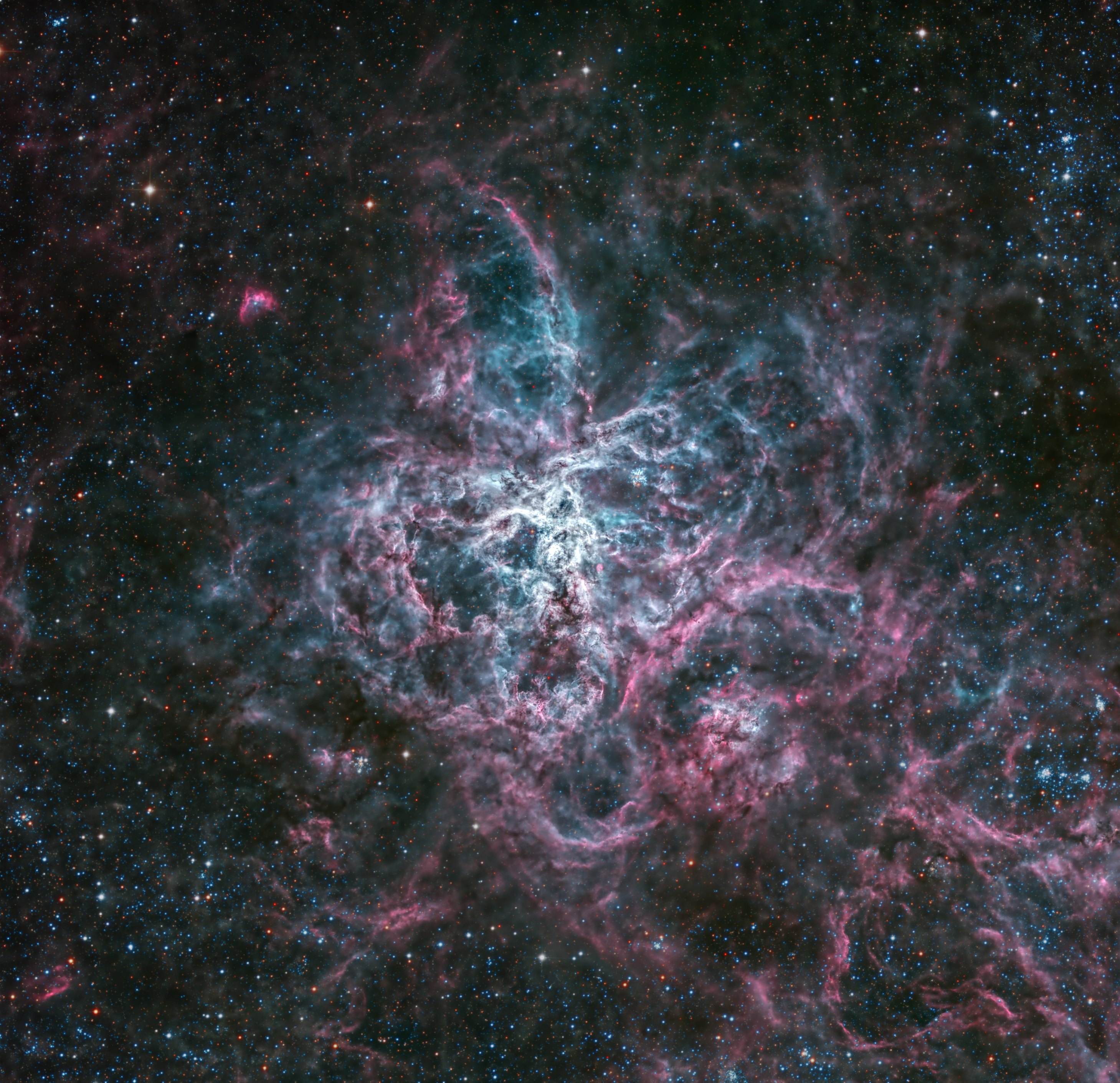 |
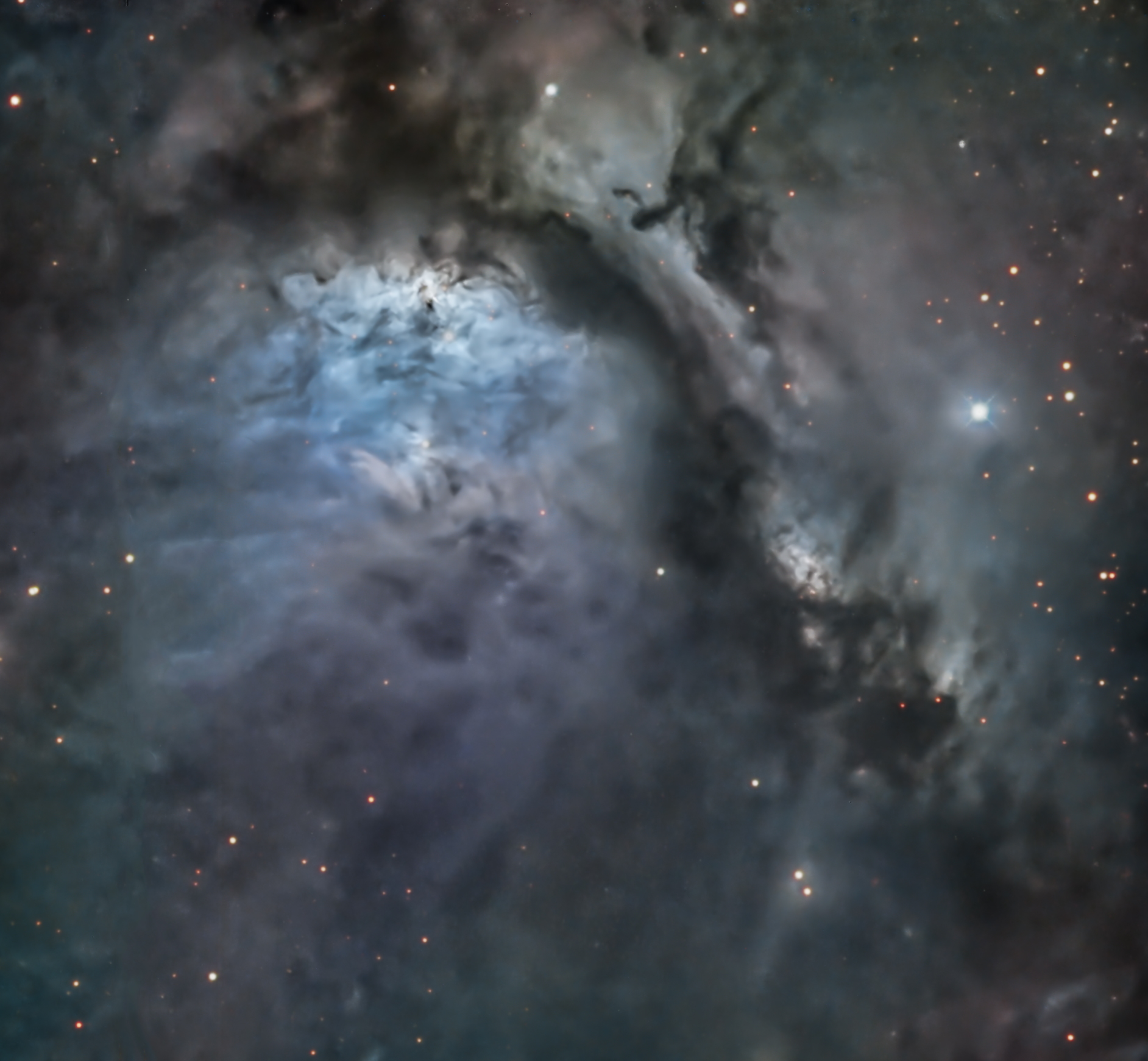 |
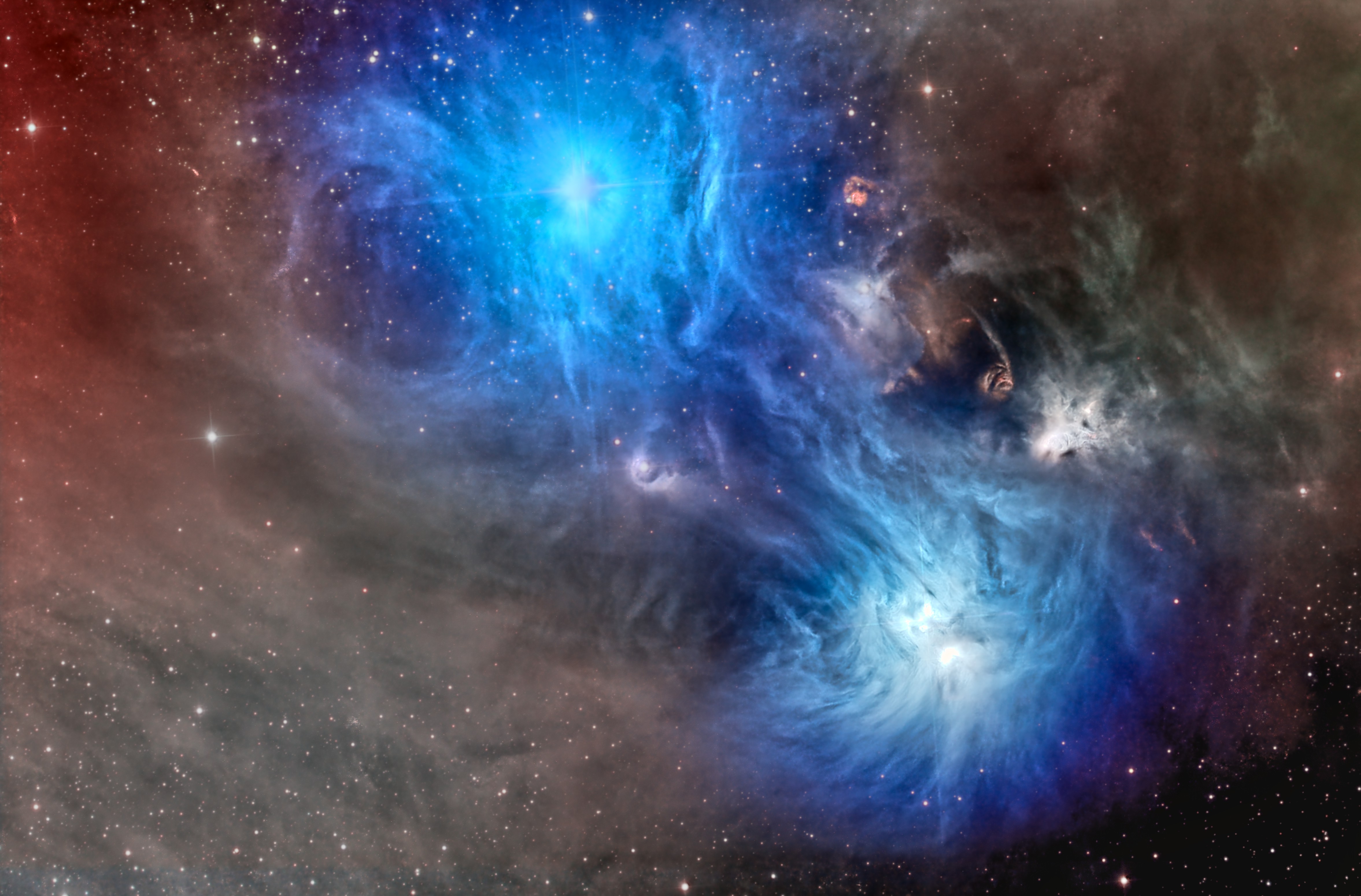 |
| Messier 97 - The Owl Nebula In the northern constellation of Ursa Major lies the Owl Nebula. It's a planetary nebula that was formed about 8,000 years ago when the primary star shed its outer atmosphere leaving behind a white dwarf. It was discovered by Pierre Mechain (who was an observing colleague of Charles Messier) in 1781. It was added to Messier's catalog one month after its discovery. Normally I wouldn't have the sky background so unnaturally dark, but I couldn't figure out how to get rid of some artifacts, so I just darkened it up to get rid of them. Image processed by Ron Yelton, original data from Telescope Live |
Messier 20 - The Trifid Nebula Discovered by Charles Messier in 1864, it is a combination of open cluster stars, emission nebula and reflection nebula. This image was done in the SHO Hubble Palette, or false color. The central area has an open cluster that sports about 3100 young, hot stars, the largest of which has the mass of about 20 sols. Image processed by Ron Yelton, original data from Telescope Live |
IC 4604 Right in the center of the blue section of this nebula lie three stars that are called Rho Ophiuchi in the constellation Ophiuchus. The surrounding gas reflects the light from these hot, young stars making this a reflection nebula. There are also some areas of dark nebulosity on the left side. The whole complex is called IC 4604. IC 4604 is one of the closest star-making regions to earth and is about 540 light-years away. Image processed by Ron Yelton, original data from Telescope Live |
|
Location: IC Astronomy
Observatory,
Spain
Date: March 2021 - April 2023 Mount: Officina Stellare EQ Mount Telescope: Officina Stellare Pro RC 700 (27" f/8) (SPA-2) Camera: FLI PL16083 @-25c Exposure: 42 x 300 min each for HSO Total: 10 hrs 30 min |
Location: El Sauce
Observatory, Chile Date: October 2023 Mount: Mathis MI-1000/1250 Telescope: Planewave CDK24 (CHI-1) Camera: QHY600m @ -30c Exposure: 85 x 5 min for HSO Total: 7 hrs |
Location:
Heaven's Mirror Observatory,
Australia
Date: October 2023 Mount: Paramount MX+ Telescope: FSQ-106ED (AUS-2) Camera: QHY600m @ -25c Exposure: 16 x 5 min each for LRGB. Total: 5hrs 40 min |
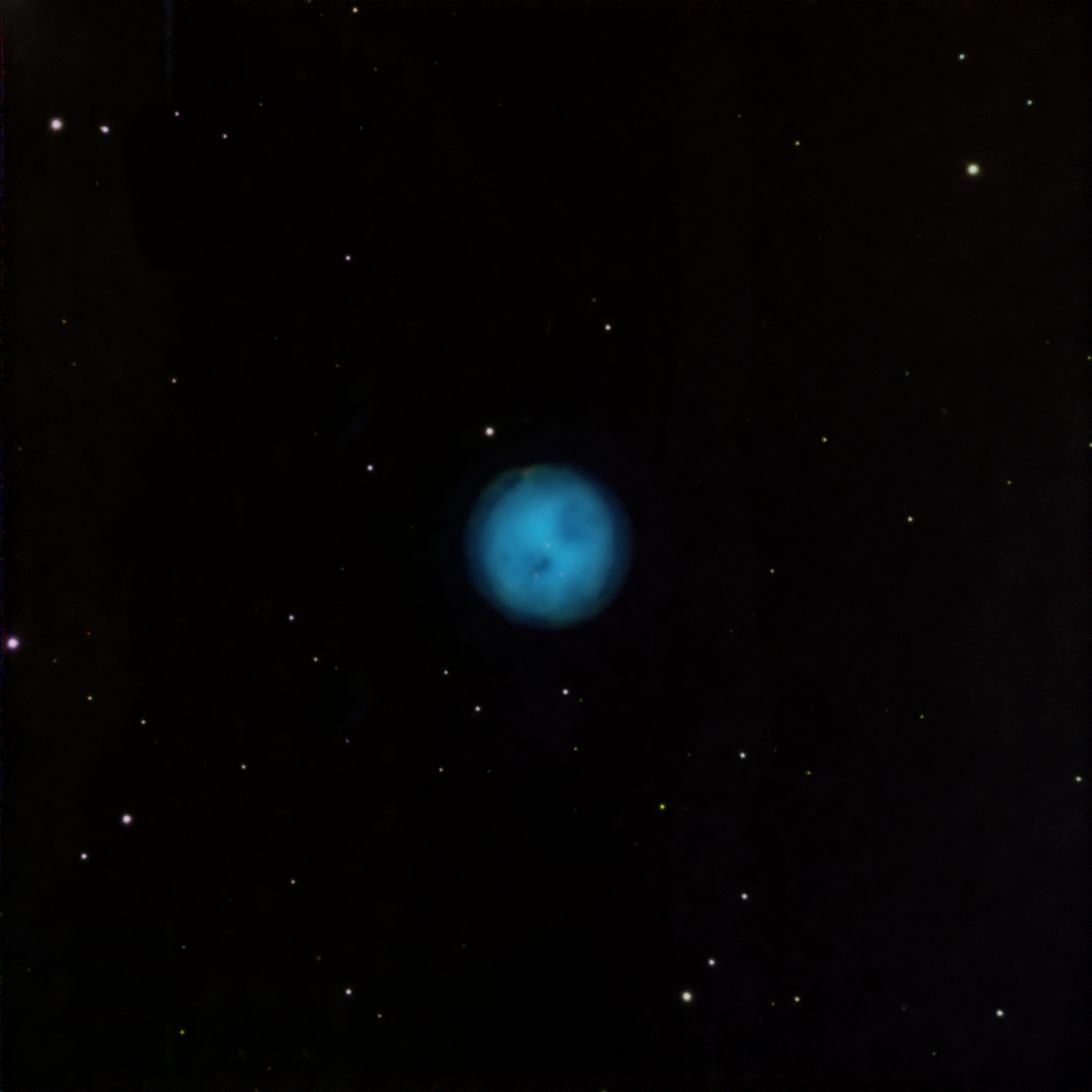 |
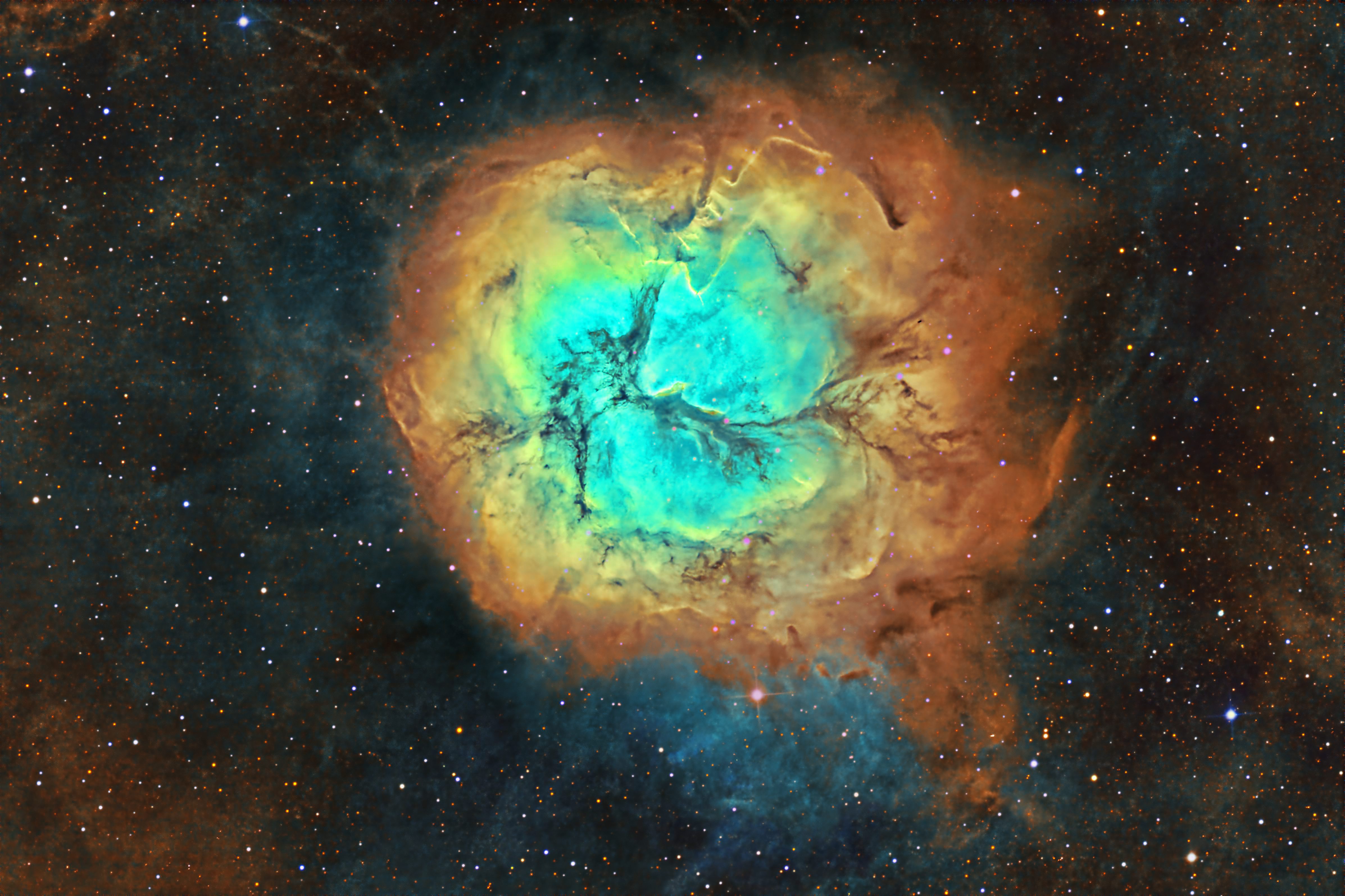 |
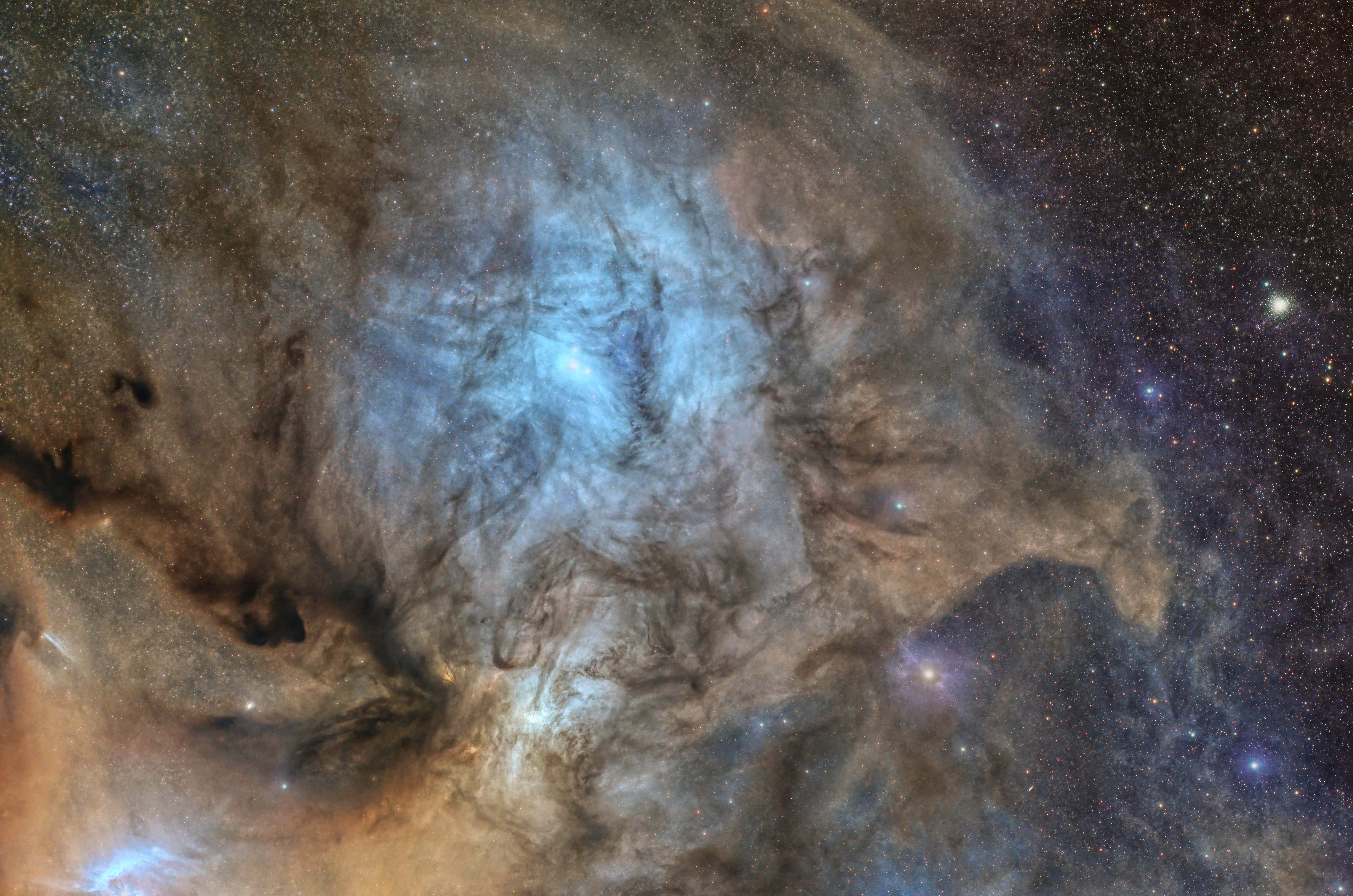 |
| Barnard 33 and NGC 2024 - The
Horsehead and Flame Nebulae The Horsehead Nebula was discovered by Williamina Fleming in 1888 on a photographic plate. It is illuminated from behind by hot, young stars. Some of their light also peeks through just to the left. The Flame Nebula on the far left side is an emission nebula, meaning that the hot, just formed stars in the middle are heating the surrounding gas until it glows. Both of these objects are some of the most imaged objects by astro photographers and are about 1350 light-years away. I think, out of all the images that I've processed, this is my favorite. it is done in SHO false color. Image processed by Ron Yelton, original data from Telescope Live |
Barnard 33 - The Horsehead Nebula This is another view of the Horsehead Nebula using a different telescope from the image to the left. The one to the left was taken with a wide field telescope, while this one used a telescope with a lot more magnifcation. What a nice closeup! in this image you can see nebulosity streaking upward. The stars behind the cloud of gas are emitting massive amounts of energy in the form of solar winds, that, as well as eroding the cloud, can actually push the gas away from the direction of the star. Image processed by Ron Yelton, original data from Telescope Live |
NGC 6188 The Fighting
Dragons of Ara and NGC 6164 The Dragon's Egg The Dragons of Ara is an emission nebula located in the constellation Ara. There are a number of massive, young stars buried in the center that are heating the surrounding gas enough that it glows. Some of the new stars are only a few million years old. It is located about 4000 light-years away. The Dragon's Egg, toward the bottom, is a planetary nebula that was created by a star about 40 times the mass of our Sun as it underwent some late-in-life convulsions. The outer halo is probably from an earlier active period of the star. Image processed by Ron Yelton, original data from Telescope Live |
|
Location:
Heaven's Mirror Observatory,
Australia
Date: October 2023 Mount: Paramount MX+ Telescope: FSQ-106ED (AUS-2) Camera: QHY600m @ -25c Exposure: 95 x 5 min each for SHO. Total: 17hrs |
Location: El Sauce
Observatory, Chile Date: October 20, 2023 Mount: Mathis MI-1000/1250 Telescope: Planewave CDK24 (CHI-1) Camera: QHY600m @ -30c Exposure: 172 x 5 min for SHO Total: 34 hrs 30 min |
Location:
Heaven's Mirror Observatory,
Australia
Date: October 2023 Mount: Paramount MX+ Telescope: FSQ-106ED (AUS-2) Camera: QHY600m @ -25c Exposure: 108 x 5 min each for HSO. Total: 21 hrs 30 min |
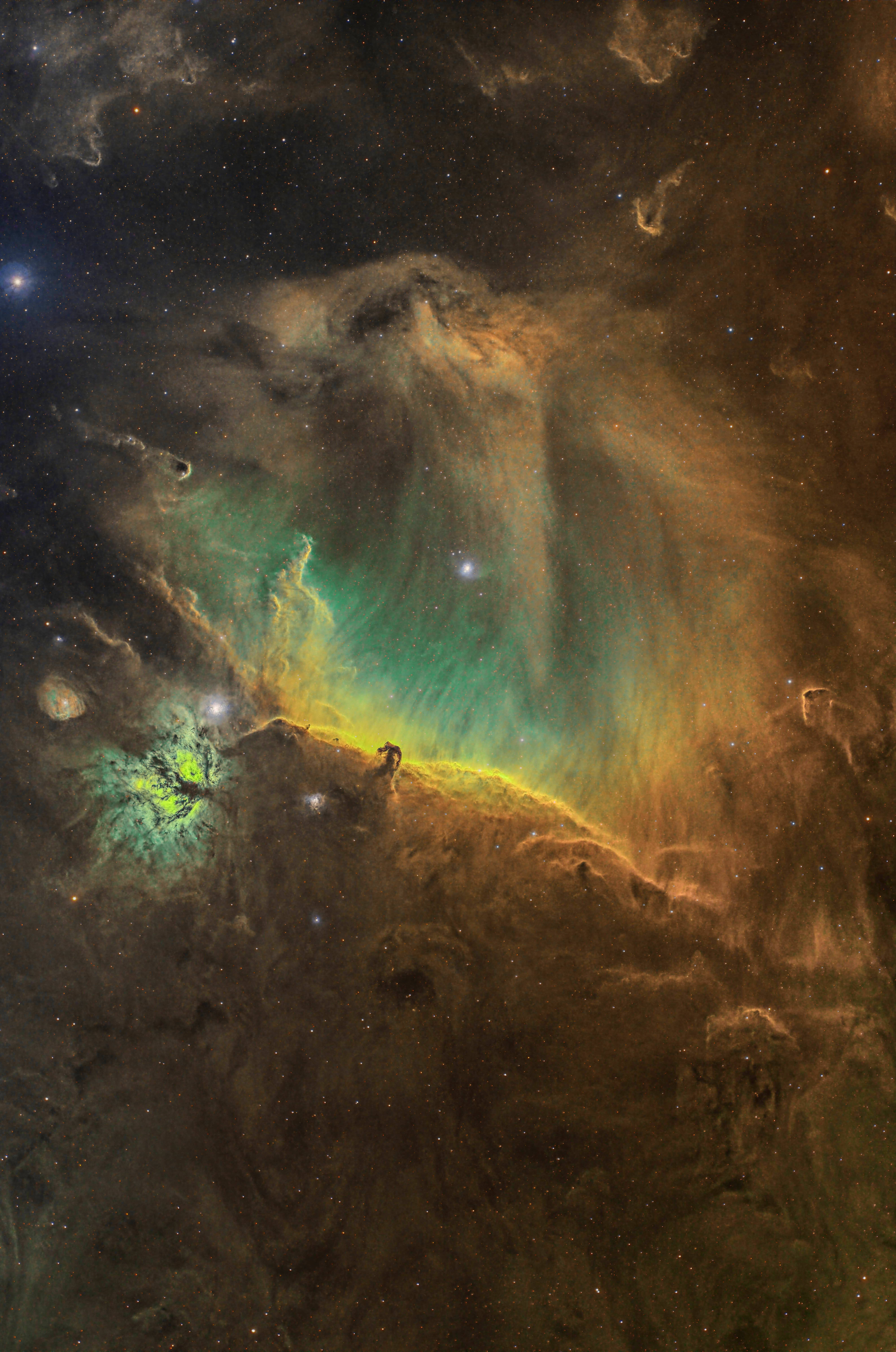 |
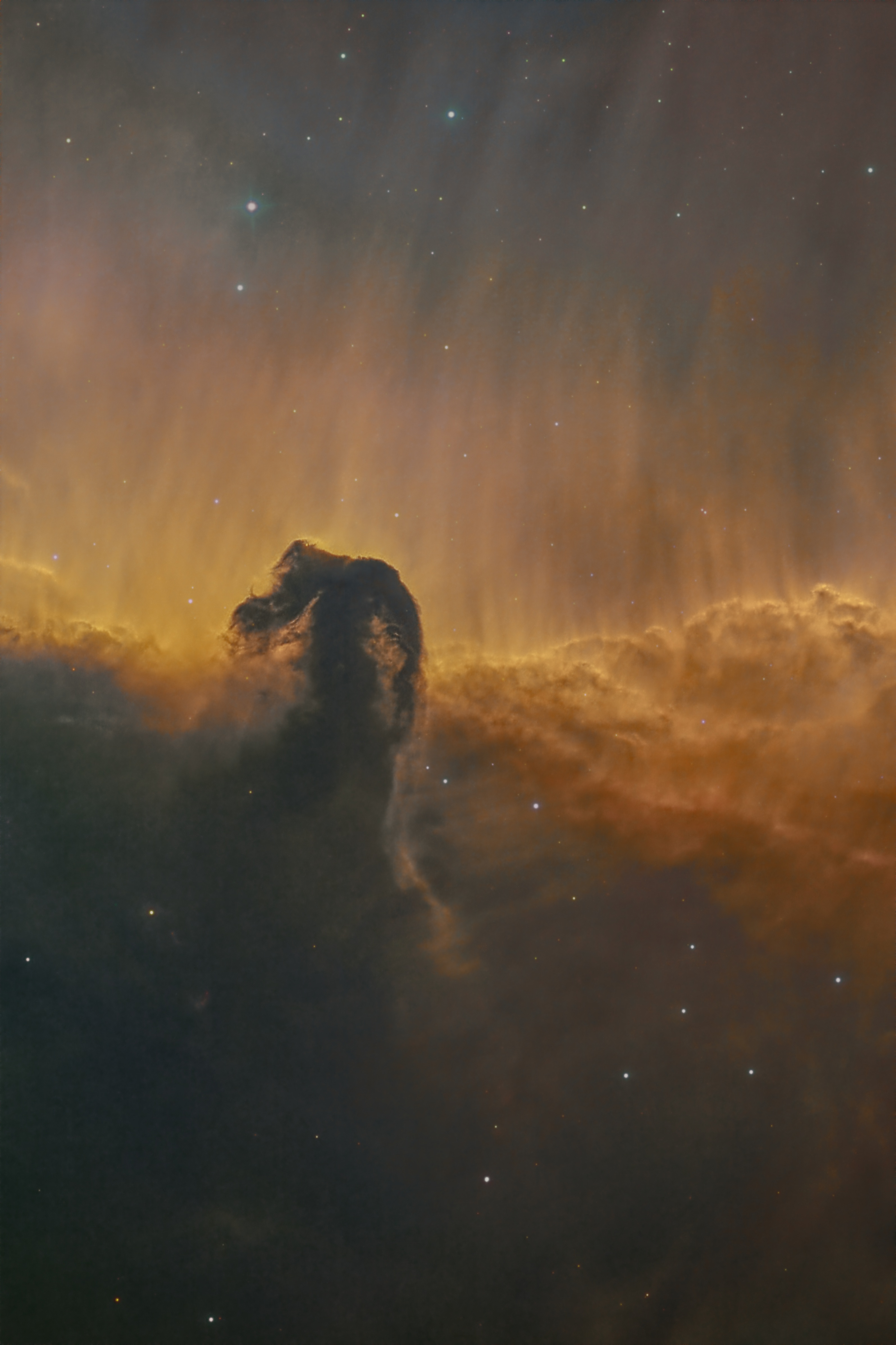 |
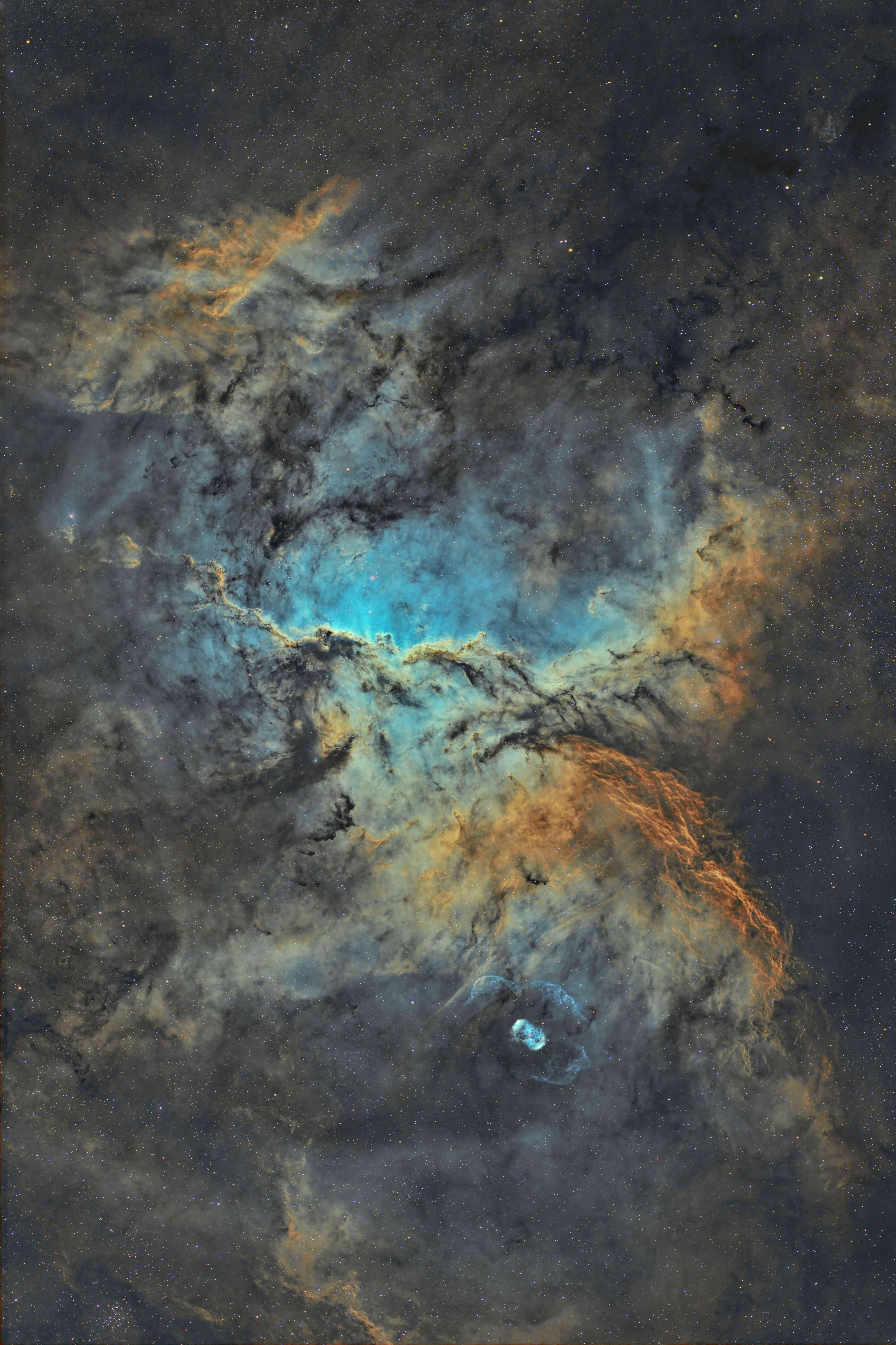 |
| IC 4685 This nebula has both reflection and emission components. It lies around 4000 light-years away and and is found in the constellation Sagittarius. It doesn't get imaged often as both M8 and M20 are right nearby. It is comprised of mostly HII gas that is usually depicted in red. Using variations of the Hubble Palette (in this case, SHO) it's fun to make something different. Image processed by Ron Yelton. Original data from Telescope Live |
Messier 1 - The Crab Nebula Originally observed by John Bevis in 1731, it was again observed independently by Charles Messier in 1758 and added to his list. It is a supernova remnant in the constellation Taurus. It is also the first astronomical object that corresponds to a historical event. The supernova was observed as a "Guest Star" in 1054 by the Chinese. At the centrer of the nebula is the original star (the Crab Pulsar) that is now a neutron star that measures about 18 miles across and spins at a rate of 30.2 times per second. This supernova remnant lies about 6500 light-years from us. The sky background is unusually black in this image. I had a lot of trouble getting rid of some processing artifacts so I ended up just making the background a bit blacker. It didn't solve the problem, just hid it. Image processed by Ron Yelton. Original data from Telescope Live |
Sh2-86, NGC 6820 and NGC 6823 There is a lot going on here in this picture. The overall area is a faint emission nebula called Sh2-86 in Vulpecula. Within this nebula lies another (reflection) nebula called NGC 6820. That is the brighter blue area in the center. In front of the blue reflection area is an area of dark nebula. The large dark column points to an open star cluster known as NGC 6823. The fun part about processing an image in false color (in this case SHO), is that you can discover a lot more detail than if you were working with regular RGB. In this, and many of the previous images you can see that these objects are often part of a much larger complex of dust and gas. Image processed by Ron Yelton. Original data from Telescope Live |
|
Location: El Sauce
Observatory, Chile Date: October 2023 Mount: Mathis MI-1000/1250 Telescope: Planewave CDK24 (CHI-1) Camera: QHY600m @ -30c Exposure: 9 x 5 min for SHO Total: 45 min |
Location: IC Astronomy
Observatory,
Spain
Date: October 2023 Mount: Officina Stellare EQ Mount Telescope: Officina Stellare Pro RC 700 (27" f/8) (SPA-2) Camera: FLI PL16083 @-25c Exposure: 94 x 2min each for SHO Total: 47 min |
Location: El Sauce
Observatory, Chile Date: October 20, 2023 Mount: Mathis MI-1000/1250 Telescope: Planewave CDK24 (CHI-1) Camera: QHY600m @ -30c Exposure: 53 x 5 min for SHO Total: 10 hrs 30 min |
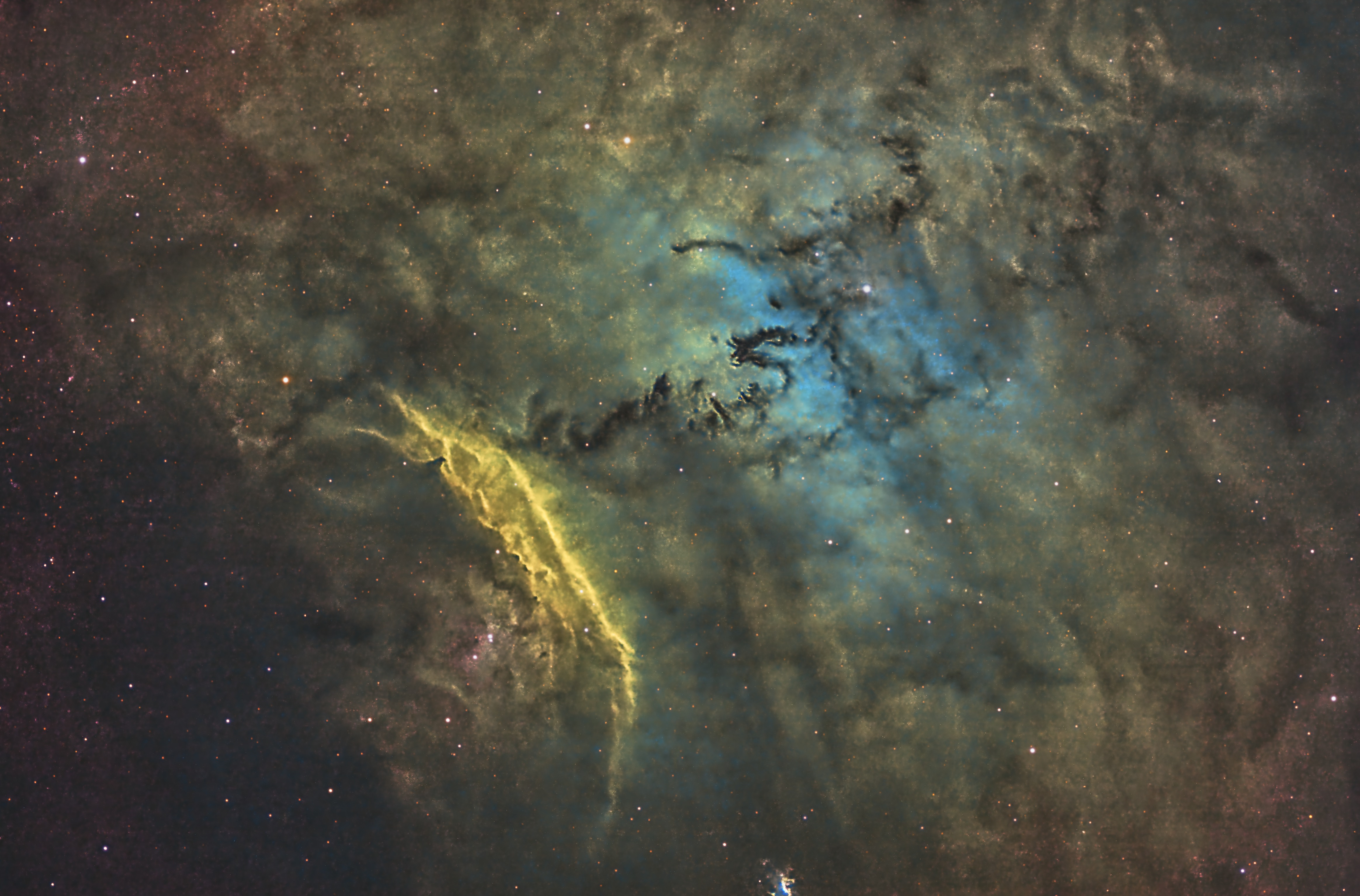 |
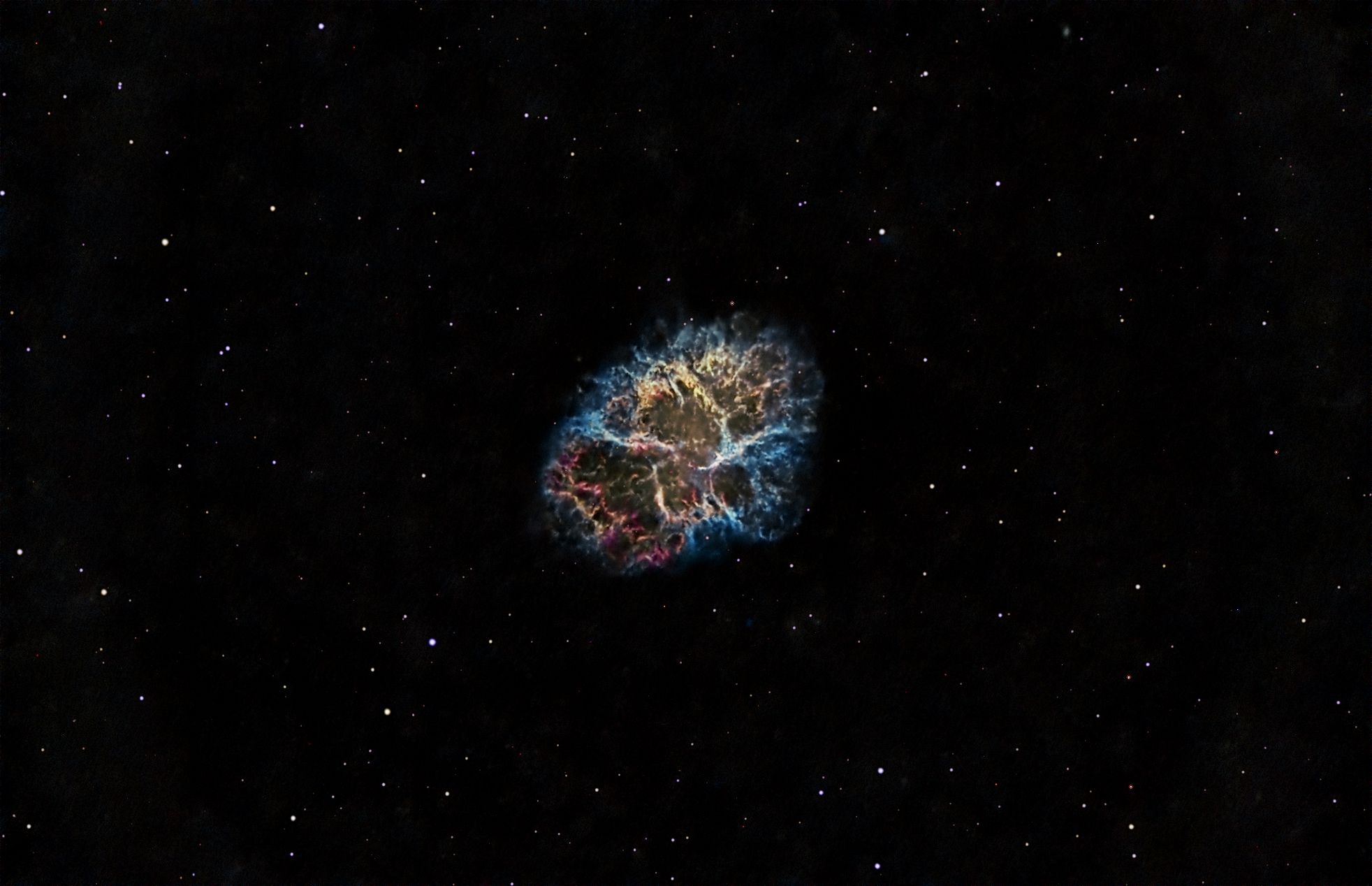 |
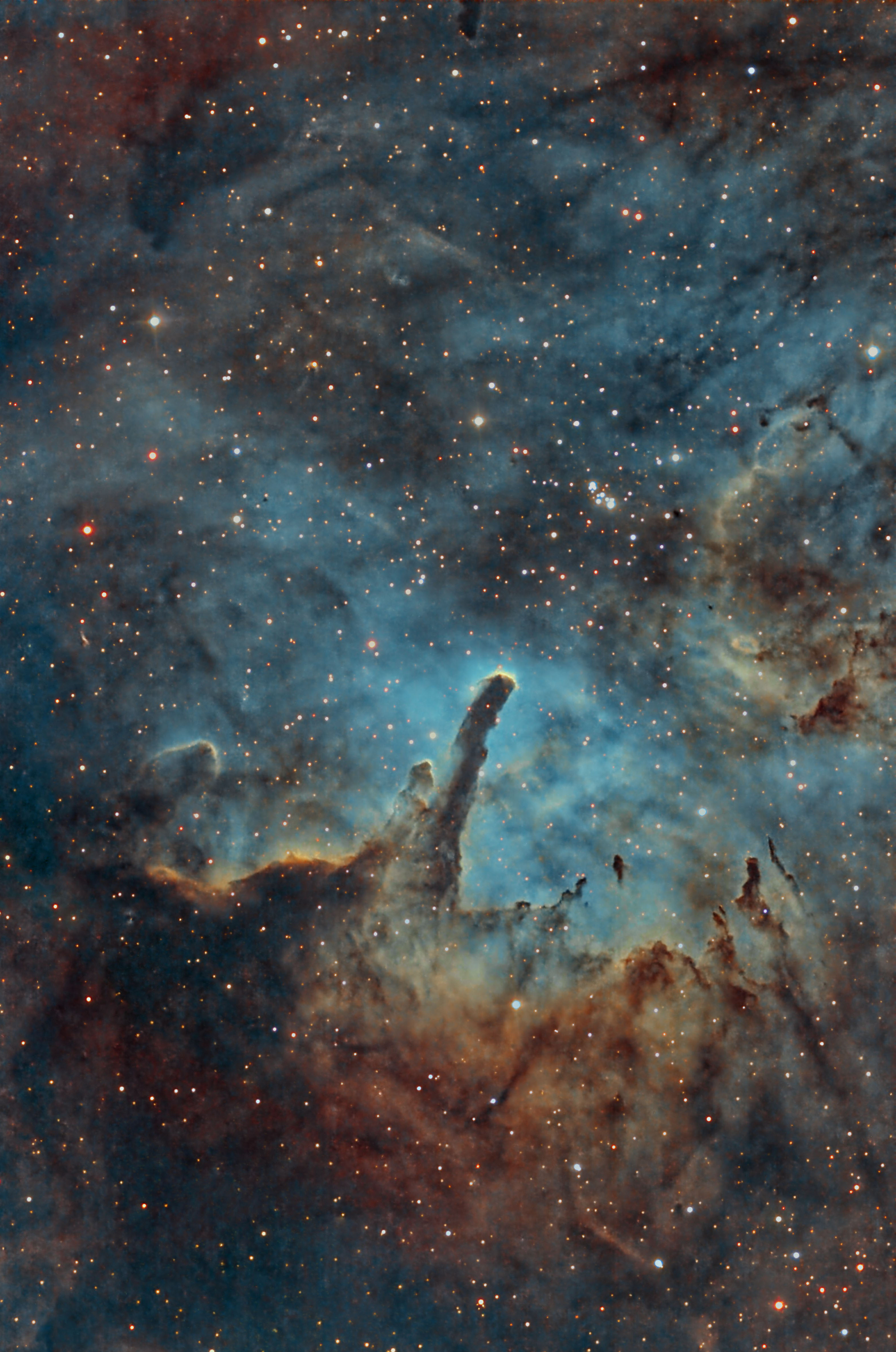 |
| NGC 1491 In the northern constellation of Perseus we have a relatively bright, but small emission nebula, NGC 1491. This image was done in false color (SHO). Normally emission nebulae are very heavy in Hydrogen II which is usually presented as red. Processing an image in different color schemes allows us to see different details at different frequencies. Image processed by Ron Yelton. Original data from Telescope Live |
NGC 3199 This is an emission nebula in the constellation Carina. It was discovered by the Scottish astronomer James Dunlop in 1826. Originally this nebula was thought to have formed as the result of "Bow Shock" from the nearby Wolf-Reyet star WR-18. As it turns out - this is just a cloud of gas and dust formed in normal space. It is also known as the Banana Nebula. Image processed by Ron Yelton. Original data from Telescope Live |
LDN 858 A dark nebula in the constellation Cygnus (The Swan) There really isn't a lot of information on this object other than it being a dark nebula. Even though it is classified as dark, with the wonders of software I was able to brighten it up a bit. This image was done in the HOO palette. Image processed by Ron Yelton. Original data from Telescope Live |
|
Location: IC Astronomy
Observatory,
Spain
Date: October 2023 Mount: Officina Stellare EQ Mount Telescope: Officina Stellare Pro RC 700 (27" f/8) (SPA-2) Camera: FLI PL16083 @-25c Exposure: 94 x 2min each for SHO Total: 47 min |
Location: El Sauce
Observatory, Chile Date: October 2023 Mount: Mathis MI-1000/1250 Telescope: Planewave CDK24 (CHI-1) Camera: QHY600m @ -30c Exposure: 68 x 10 min for SHO Total: 11 hrs 20 min |
Location: IC Astronomy Observatory, Spain
Date: September 2023 Mount: Paramount MX+ Telescope: Takahashi FSQ-106ED (SPA-1) Camera: QHY600m CMOS @ -30c Exposure: HOO 90 x 5 min Total: 7.5 hrs |
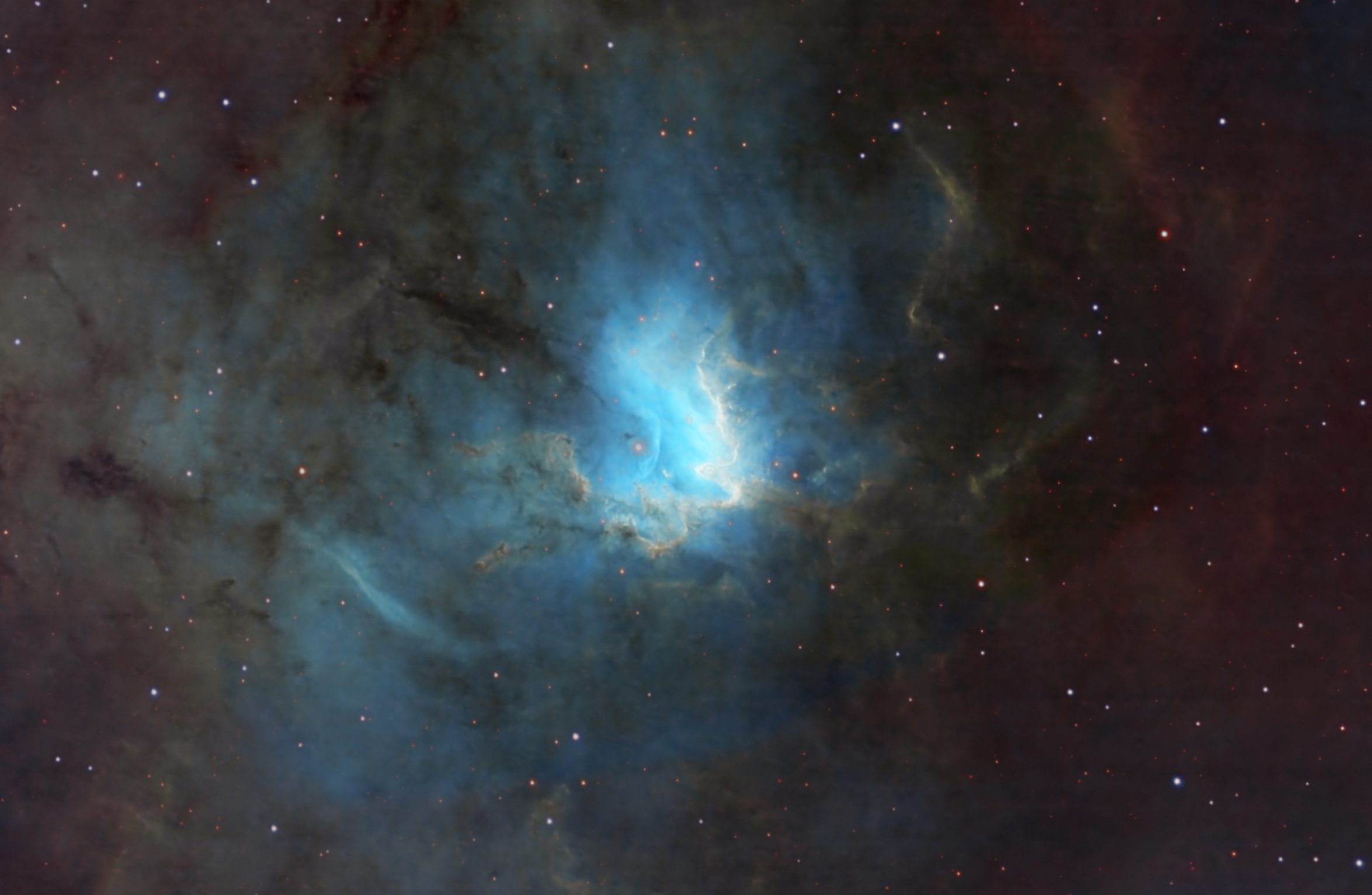 |
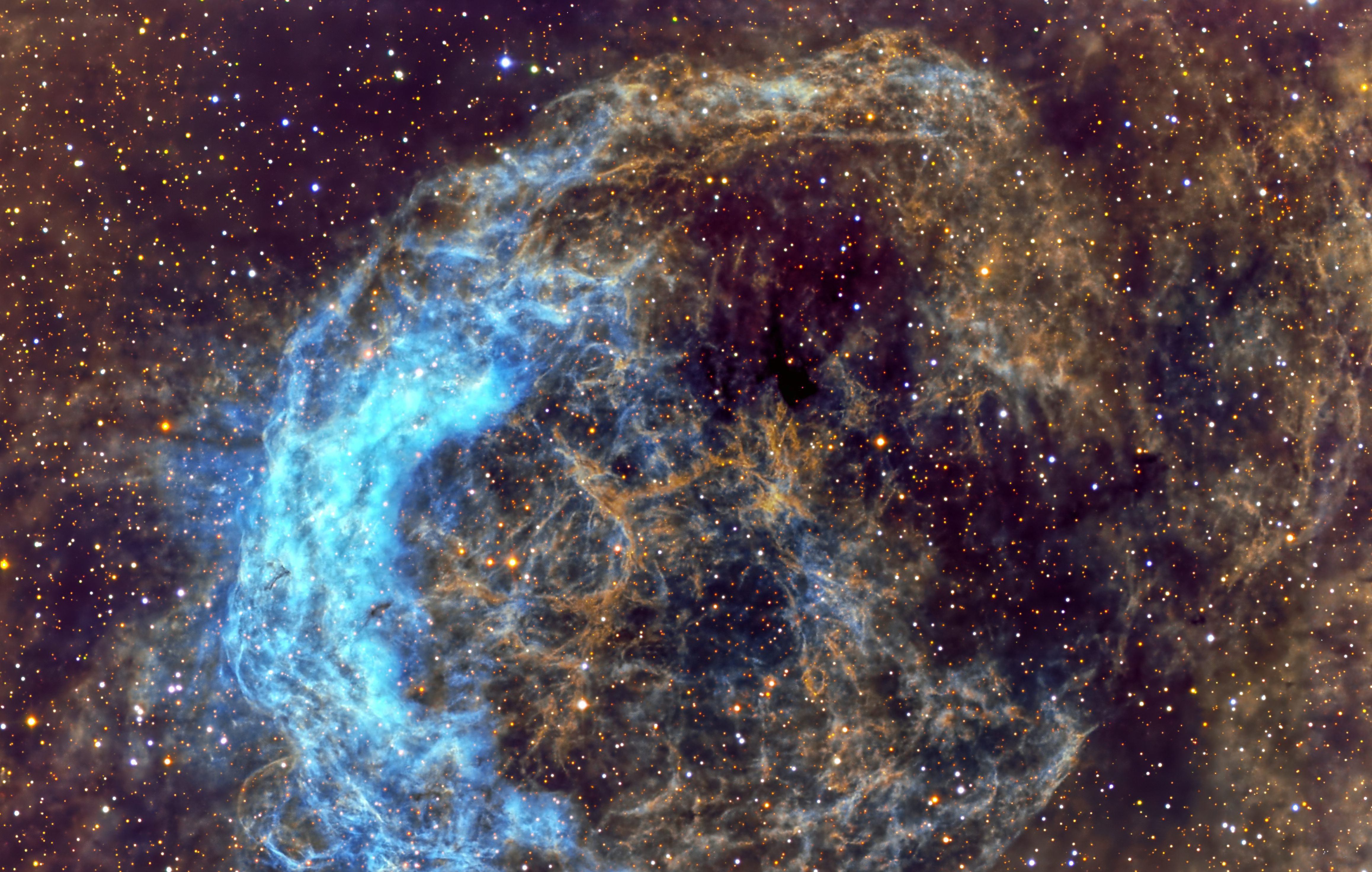 |
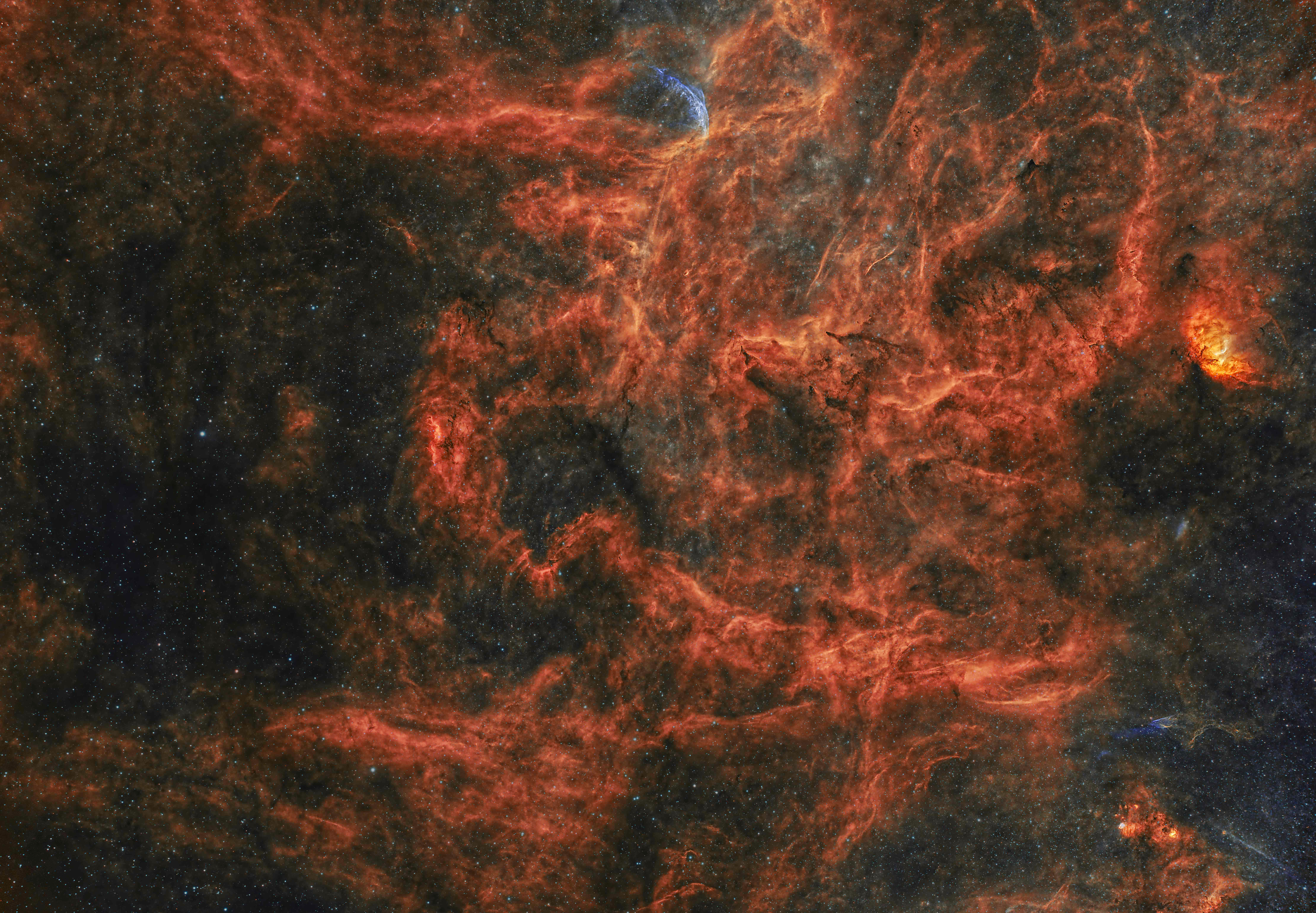 |
| Sh2-190 and Sh2-199 - The
Heart and Soul Nebulae Sh2-190
– The Heart
Nebula is an
emission
nebula located
in the
constellation
Cassiopeia. It
lies about
7500
light-years
from Earth. It
is comprised
primarily of
Hydrogen gas
as well as
smaller
amounts of
ionized Oxygen
and Sulphur
gasses. Its
shape is due
to solar winds
from a small
open cluster
near the
center. This
open cluster
can claim a
number of
stars that are
more than 50x
the mass of
the Earth. The
Heart Nebula
is the one in
the
lower-right. Sh2-199
= The Soul
Nebula is also
in Cassiopeia
and is 7500
light-years
away. It
contains
numerous small
open clusters
and other
small emission
nebulae. There are a couple of small
galaxies
nearby. These two nebulae are usually referred together as the Heart and Soul Nebulae.
|
RCW 16,
Sh2-311 (NGC 2467) - Skull
and Crossbones Nebula This nebula is located in the constellation Puppis. Puppis being the poop deck of the ship Argo, sailed by Jason and the Argonauts of Greek mythology. Some say that if you look at the image just right it looks like the face of a mandril. This nebula is a region of gasses that form a large star-making factory. Recent studies have detected at least 45 proto-stars (in the process of being formed). The region is dominated by the massive young star on the left side. Image processed by Ron Yelton. Original data from Telescope Live |
Messier 78 Messier 78 is a reflection nebula in the constellation Orion. It lies about 1350 light-years away from us. It is the brightest nebula in its local area that includes other nebulae such as NGC 2064, 2076 and 2071. The are two new stars behind the gas in the center that provide the light that reflects off the gas. The two stars can be seen only with infrared imaging. Image processed by Ron Yelton. Original data from Telescope Live |
|
Location: IC Astronomy Observatory, Spain Date: November 2020 - September 2022 Mount: Paramount MX+ Telescope: FSQ-106EDX4 (SPA-3) Camera: FLI PL16083 Exposure: 90 x 10 min for SHO Total: 7 hrs |
Location: El Sauce
Observatory, Chile Date: November 2023 Mount: Mathis MI-1000/1250 Telescope: Planewave CDK24 (CHI-1) Camera: QHY600m @ -30c Exposure: 68 x 5 min for SHO Total: 5 hrs 40 min |
Location: El Sauce
Observatory, Chile Date: November 2023 Mount: Mathis MI-1000/1250 Telescope: Planewave CDK24 (CHI-1) Camera: QHY600m @ -30c Exposure: 111 x 5 min for SHO Total: 10 hrs 20 min |
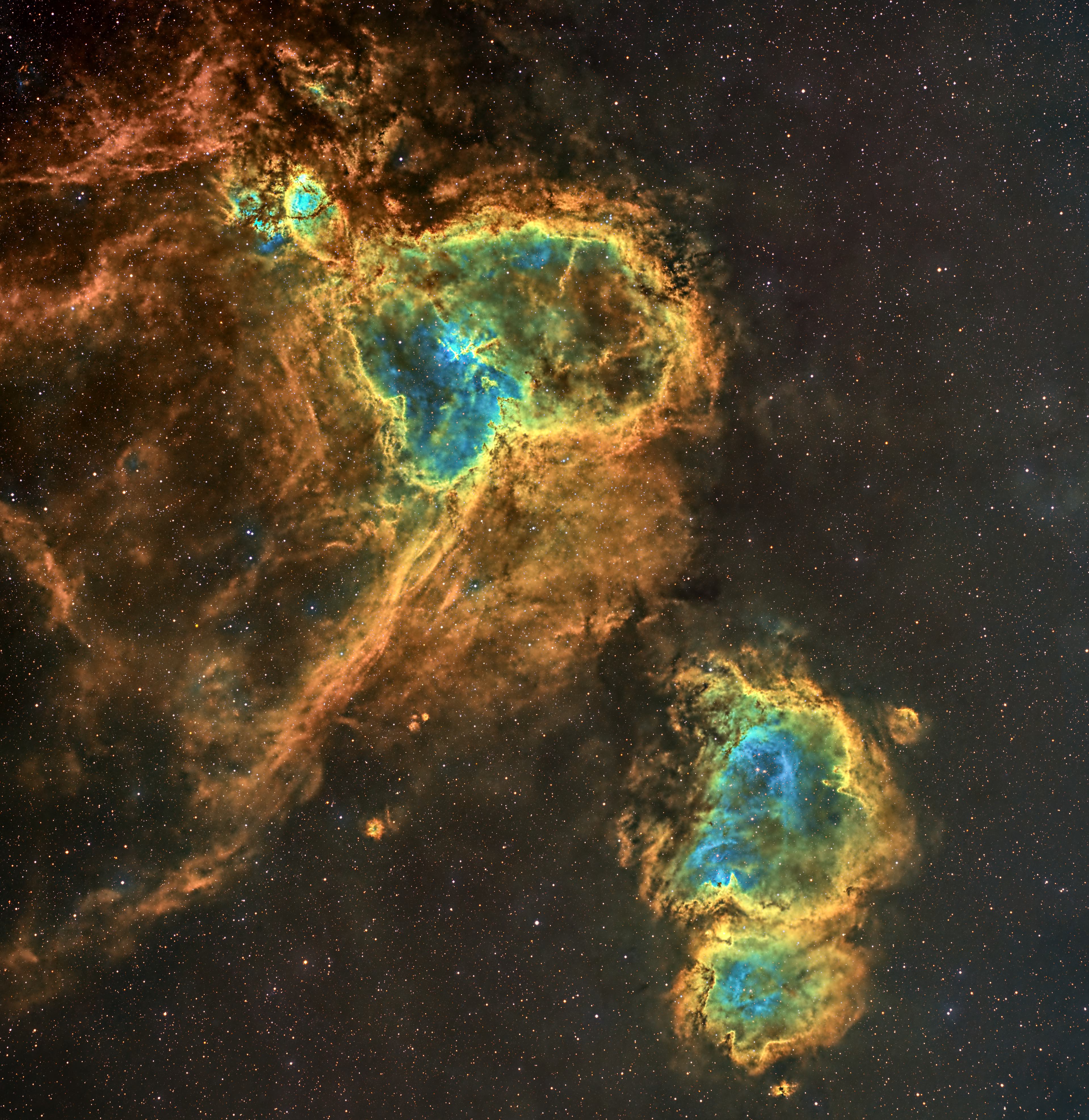 |
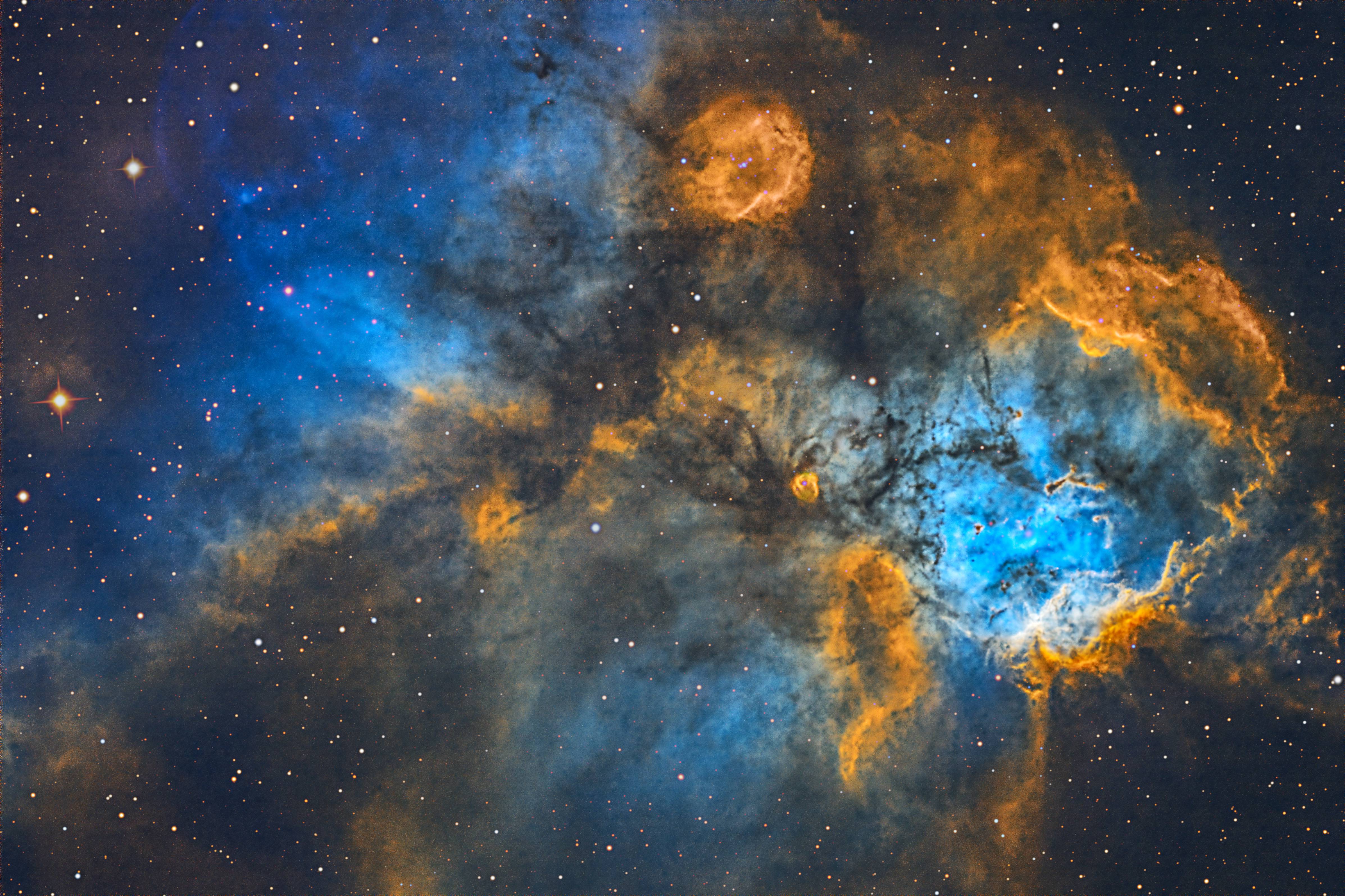 |
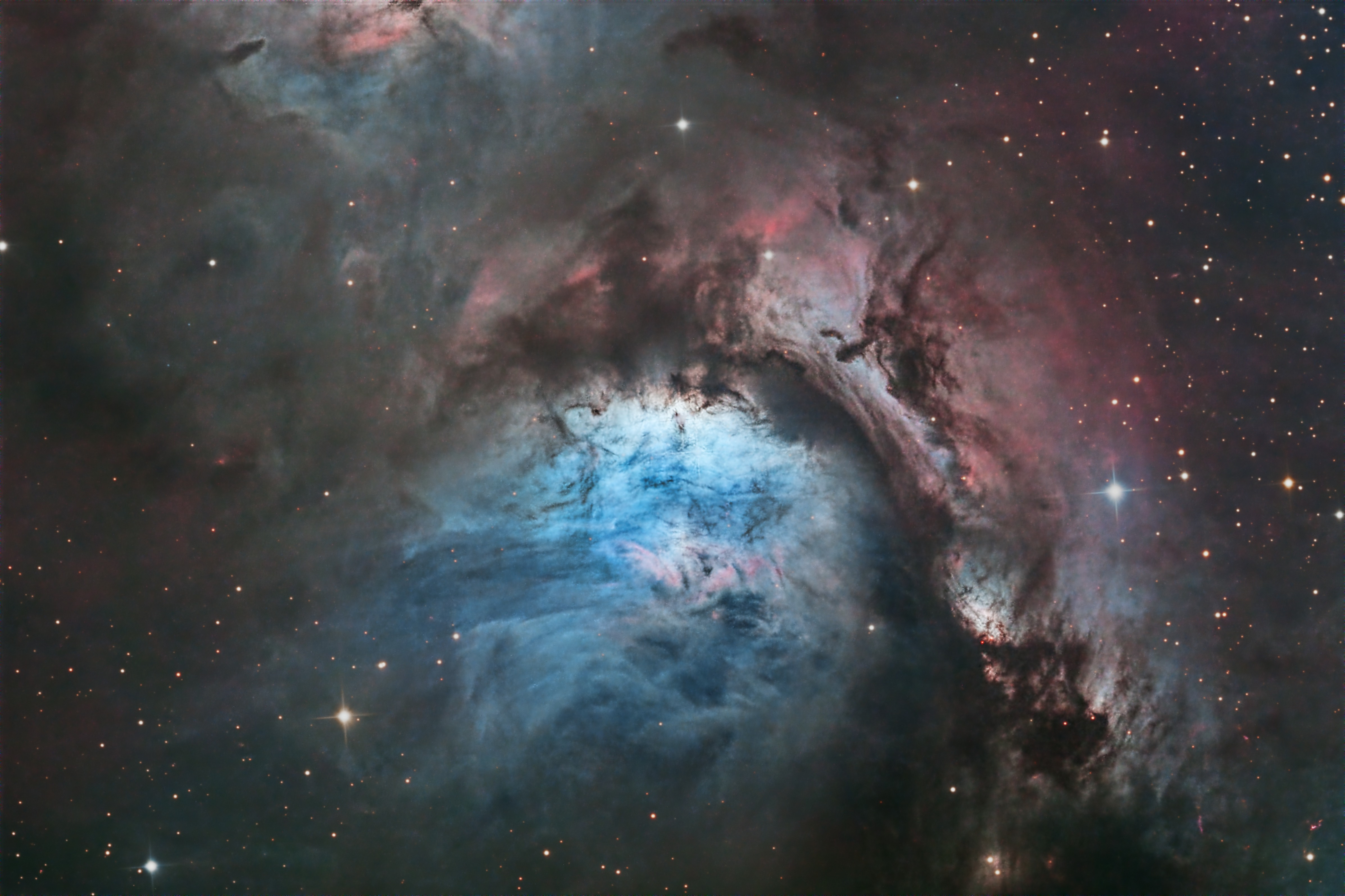 |
| Sh2-297 This object is an emission nebula that sits in the constellation of Canis Major. It is actually the bright area in the center, and is part of the larger nebula Sh2-296 (The Seagull Nebula). it is about 4000 light-years away from us. Image processed by Ron Yelton. Original data from Telescope Live |
Messier 16 - The
Eagle Nebula (Pillars of Creation) ln the constellation Serpens lies Messier 16, a diffuse emission nebula. It is about 5700 light-years from Earth and contains numerous active star making regions and clusters, the main cluster containing around 8100 stars. The Eagle Nebula was made famous in 1995 when a Hubble image was released that came to be named "The Pillars of Creation." The Pillars are an excellent example of the erosion of the molecular cloud that formed the hot, new stars. The intense radiation from the new stars is what causes the erosion. This a slightly different version that the one above. Image processed by Ron Yelton, original data from Telescope Live |
NGC 2174 - The
Monkey Head Nebula The Monkey Head is located in the constellation Orion and is about 6400 light-years away. The monkey's head is the large, round structure in the upper-right. There is an open cluster of very hot, young new stars just to the upper-right of center. These stars emit huge amounts of radiation in the form of stellar winds that erode and blow away gas which leaves behind unusually shaped structures like those in the lower half of the image. The color palette is SHO. Image processed by Ron Yelton, original data from Telescope Live |
|
Location: El Sauce
Observatory, Chile Date: December 2023 Mount: Mathis MI-1000/1250 Telescope: Planewave CDK24 (CHI-1) Camera: QHY600m @ -30c Exposure: 95 x 5 min for SHO Total: 7 hrs 25 min |
Location:
El Sauce Observatory, Chile Date: February - April 27, 2020 Mount: Mathis MI-1000/1250 Telescope: Planewave CDK24 (CHI-1) Camera: QHY600m @ -25c Exposure: 24 x 10 min for LRGB Total: 2 hrs |
Location: El Sauce
Observatory, Chile Date: December 2023 Mount: Mathis MI-1000/1250 Telescope: Planewave CDK24 (CHI-1) Camera: QHY600m @ -25c Exposure: 44 x 5 min for SHO Total: 3 hrs 40 min |
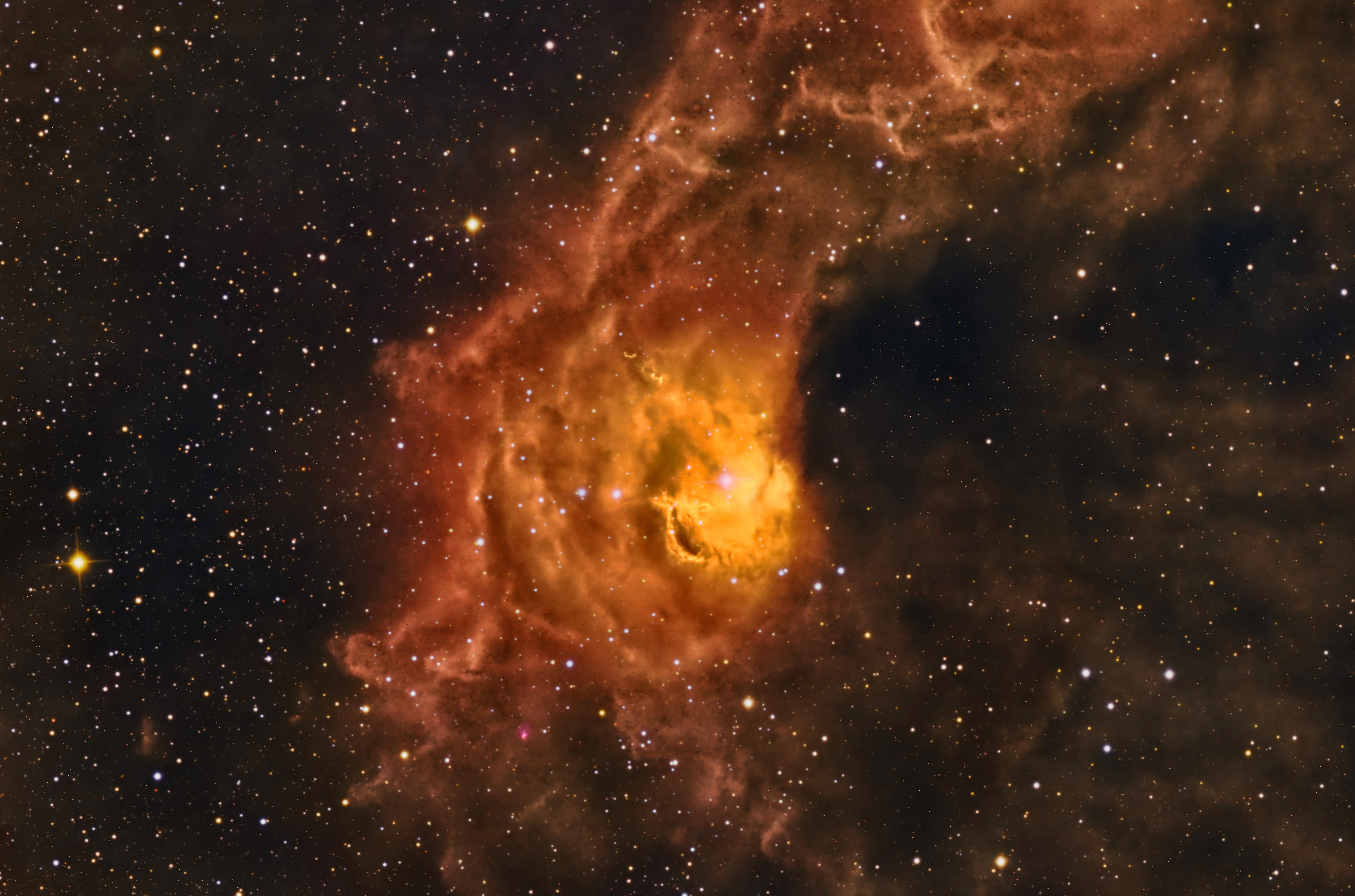 |
 |
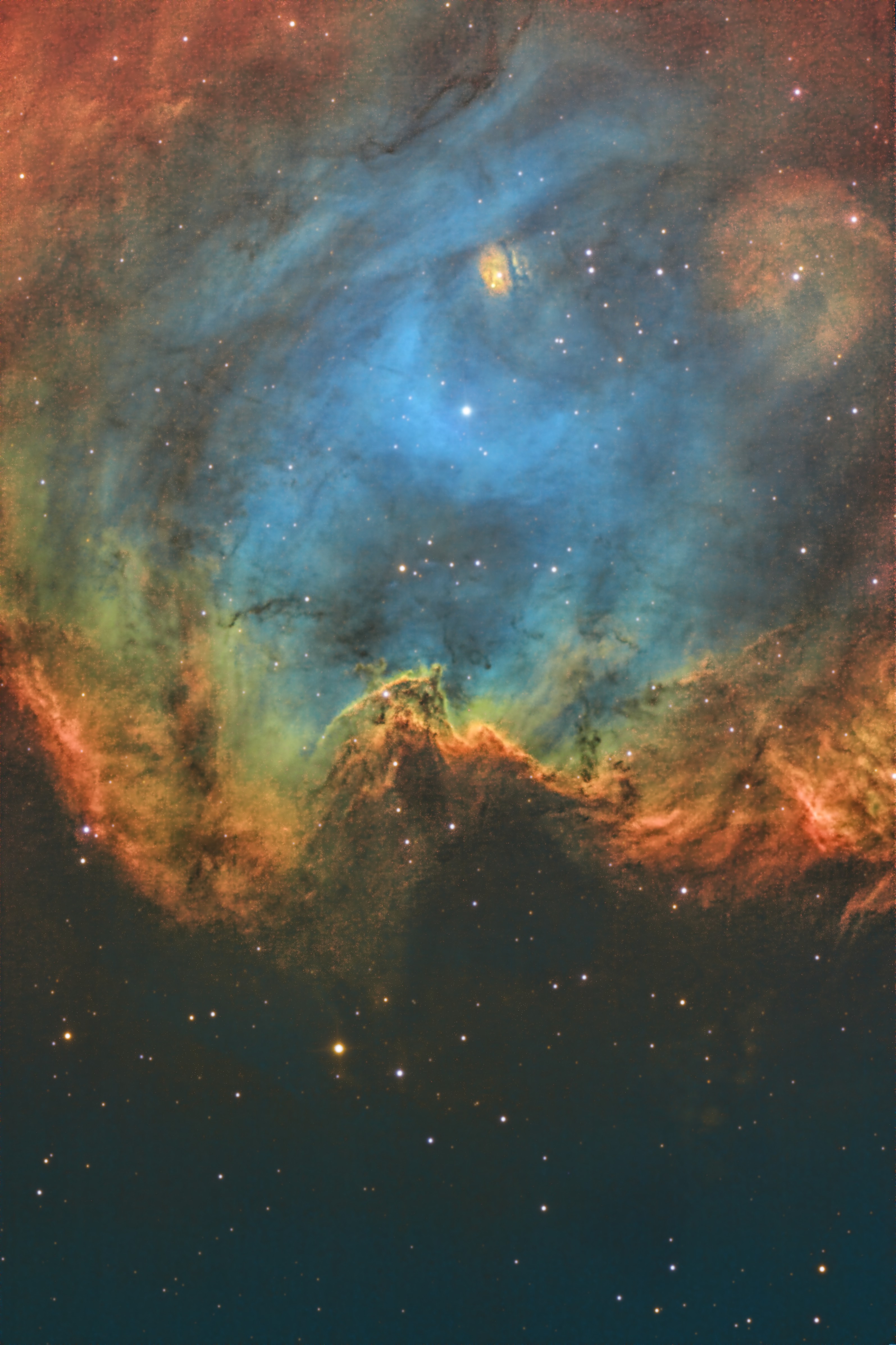 |
| RCW 19 This emission nebula is just a small part of a greater molecular cloud in Puppis that weighs in at about 200,000 solar masses. The color palette is OHS. Image processed by Ron Yelton. Original data from Telescope Live |
IC 405 - The Flaming
Star
or Auriga Nebula There's a lot of action packed into this object. First of all, it is both an emission and reflection nebula that lies about 1500 light-years away from us. The bright reddish area to the left is IC 405, The Flaming Star Nebula. At the center-top is IC410. this reflection nebula also contains an embedded open cluster - NGC 1893. Just outside of the image there are a couple more clusters. Image processed by Ron Yelton. Original data from Telescope Live |
SH2-129 -
The Flying Bat Nebula In the constellation Cepheus is the large nebula - The Flying Bat, and right in the middle is the very faint Squid Nebula. This one was really difficult to process. Just couldn't figure out how to bring out the purplish Squid. This one would be worth re-doing sometime when I have a little more Pixinsight under my belt. They both lie about 2300 light-years away and the Squid nebula is about 50 light-years across. Image processed by Ron Yelton, original data from Telescope Live |
|
Location:
Heaven's Mirror Observatory,
Australia
Date: December 2023 Mount: Paramount MX+ Telescope: FSQ-106ED (AUS-2) Camera: QHY600m @ -25c Exposure: 52 x 5 min each for OHS. Total: 4hrs 20 min |
Location: IC Astronomy Observatory, Spain
Date: December 2023 Mount: Paramount MX+ Telescope: Takahashi FSQ-106ED (SPA-1) Camera: QHY600m CMOS @ -30c Exposure: 33 x 5 min (HSO) Total: 5 hrs 15 min |
Location: IC Astronomy Observatory, Spain
Date:September - December 2023 Mount: Paramount MX+ Telescope: Takahashi FSQ-106ED (SPA-1) Camera: QHY600m CMOS @ -30c Exposure: 189 x 5 min (HSO) Total: 15 hrs 45 min |
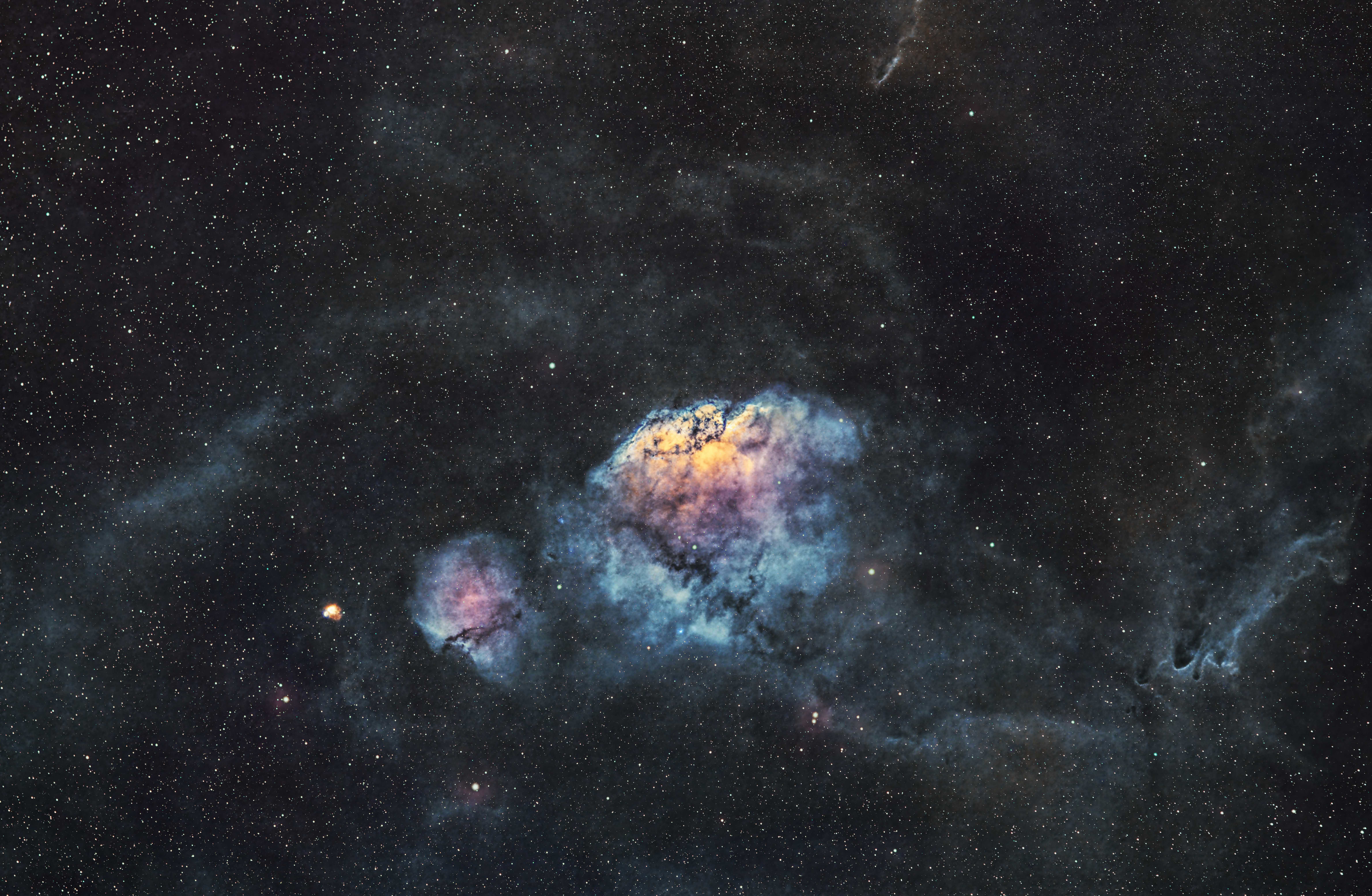 |
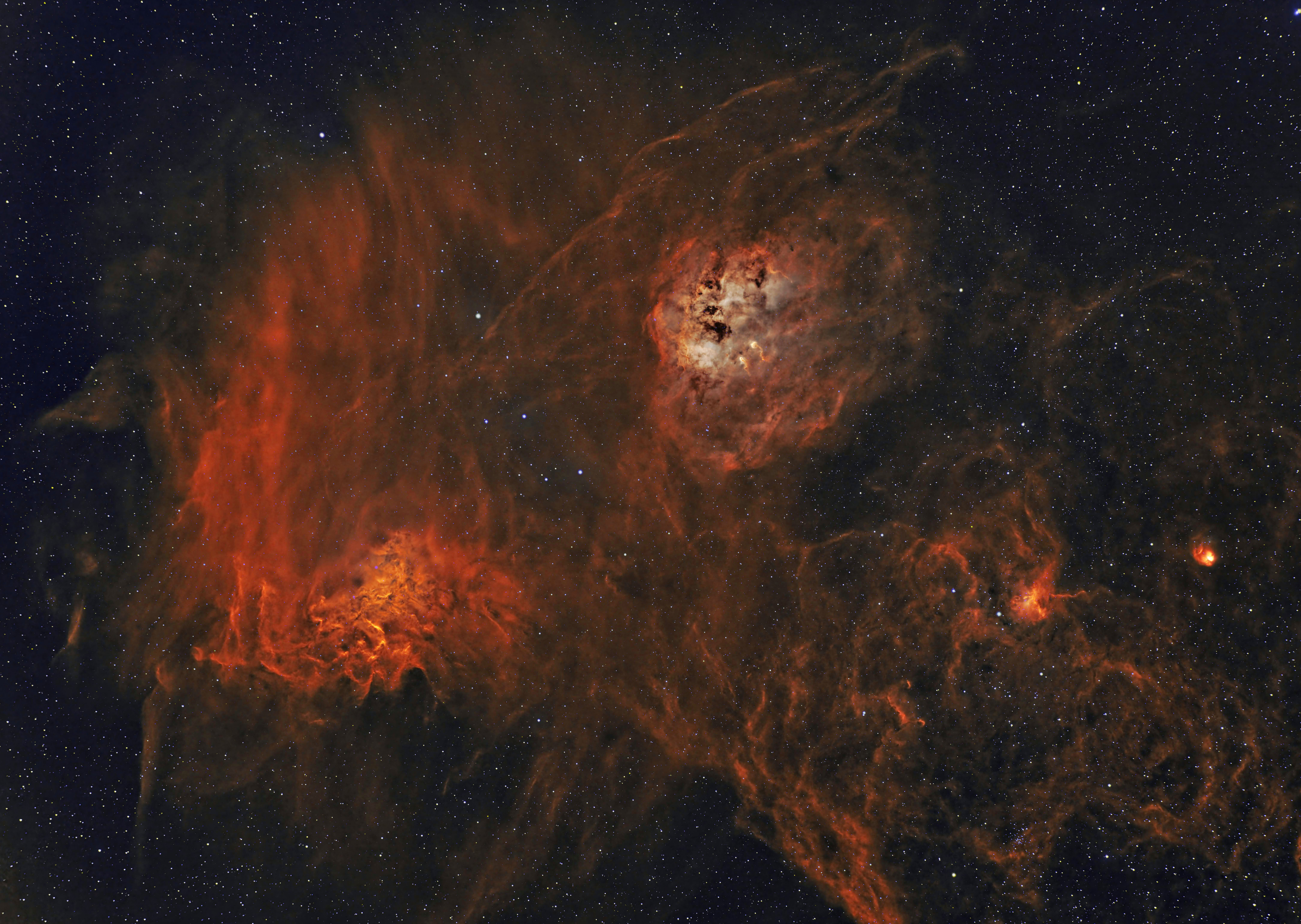 |
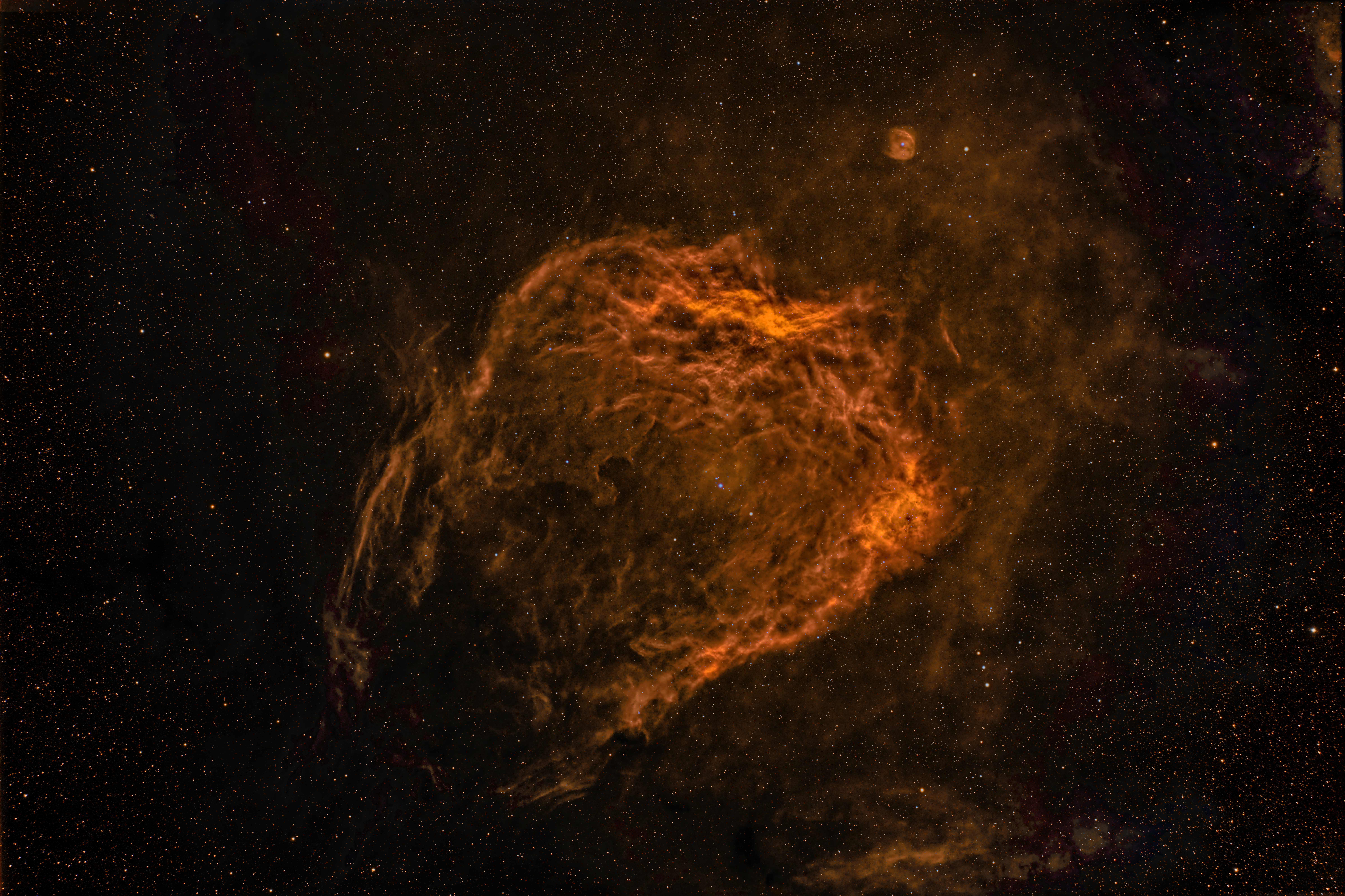 |
| NGC 2264 This nebula is in the constellation Monoceros. It lies about 2700 light-years away from us. NGC 2264 actually refers to two objects The Cone Nebula and the Christmas Tree Nebula. Also within this huge reflection nebula are the Fox Fur and Snowflake Nebulae. Image processed by Ron Yelton. Original data from Telescope Live |
|
Location: IC Astronomy Observatory, Spain
Date:September - December 2023 Mount: Paramount MX+ Telescope: Takahashi FSQ-106ED (SPA-1) Camera: QHY600m CMOS @ -30c Exposure: 63 x 5 min (OHS) Total: 5 hrs 15 min |
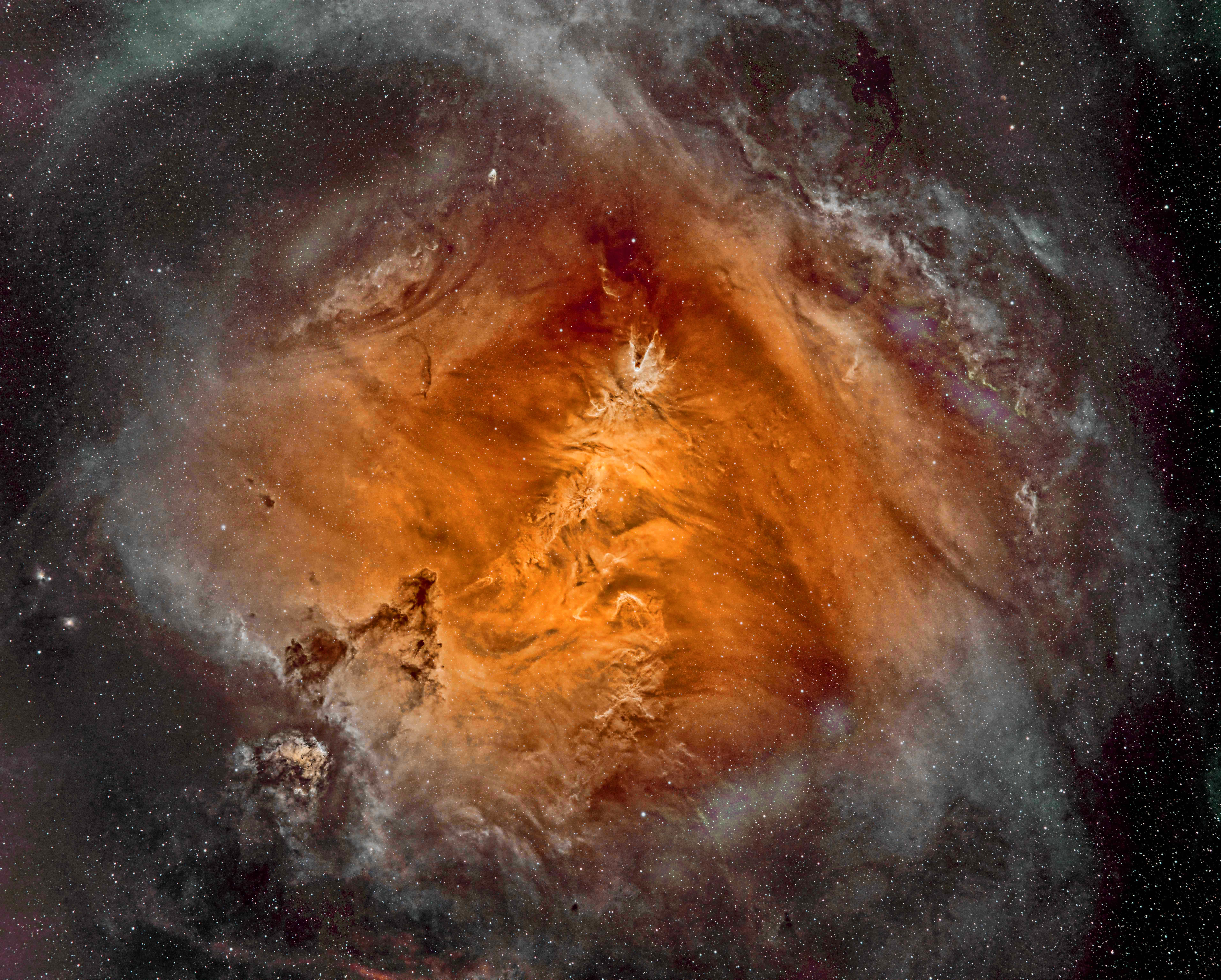 |
Except as noted all images Copyright © by Ron Yelton and may not be used without permission.